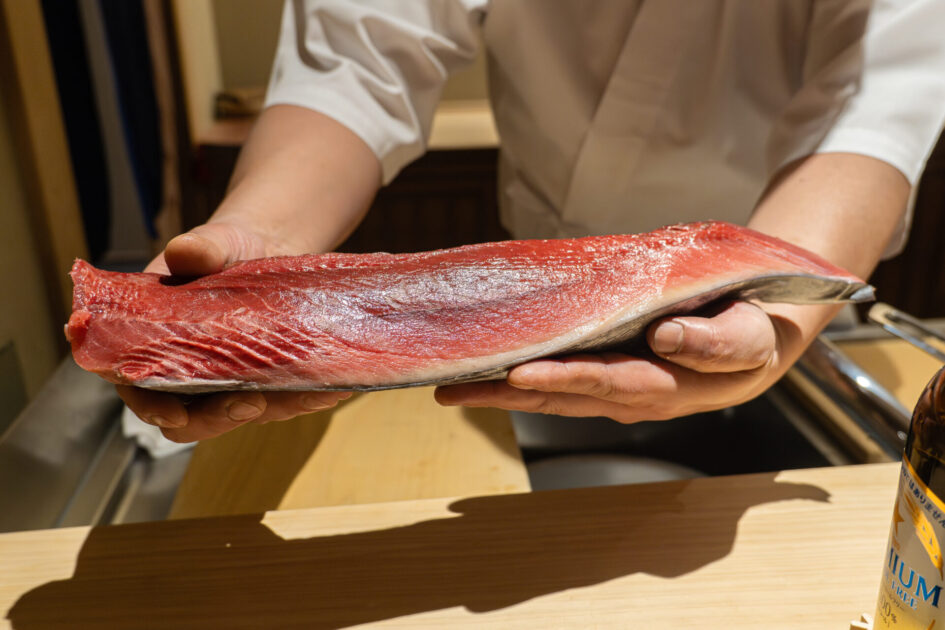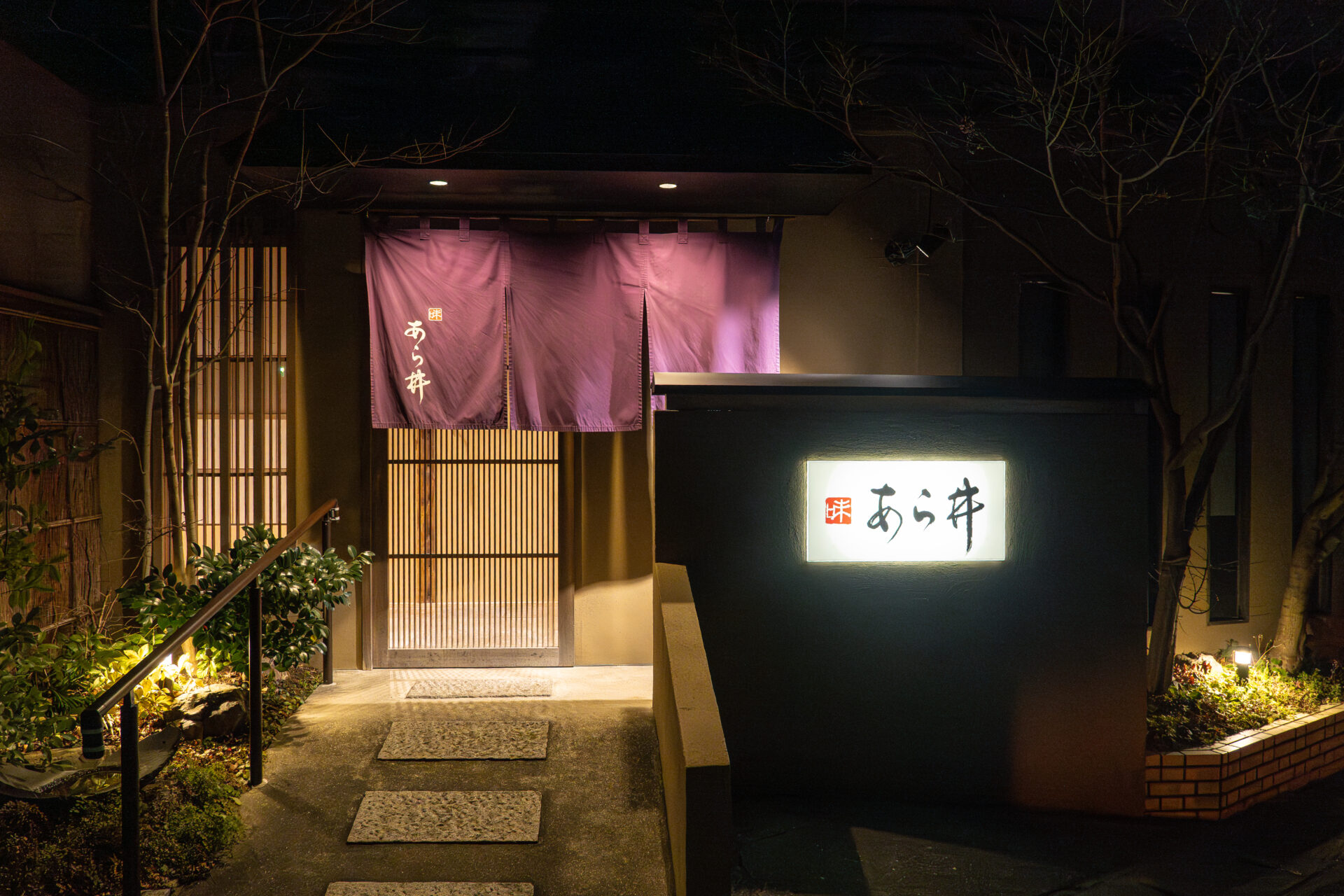
CONTENTS
About Aji Arai
Concept
Located in Nakatsu City, Oita Prefecture, Aji Arai is a Japanese restaurant that offers “Kyushu Kappo” cuisine, showcasing the finest ingredients sourced from across the Kyushu region.
The restaurant features seasonal ingredients at their peak, such as fresh seafood and wild game, sourced directly from local fishermen and producers. Each dish is carefully crafted to bring out the natural flavors of these premium ingredients.
Chef Arai also values deep connections with the local community, actively incorporating tableware crafted by young local artisans. This commitment reflects a philosophy of creating delicious food through collaboration with the region as a whole.
In this way, Aji Arai offers a truly special culinary experience, combining the full appeal of Kyushu’s ingredients with warm hospitality deeply rooted in the local culture.
Chef Hiroyoshi Arai
Chef Hiroyoshi Arai developed a love for cooking from an early age, influenced by his grandmother who sold fish door-to-door. Inspired to pursue Japanese cuisine in high school, he went on to study at a culinary school.
After graduating, he trained for about nine years at Yoshike, a renowned restaurant in Nishinakasu, Fukuoka. In September 2011, he returned to his hometown of Nakatsu and opened Aji Arai.
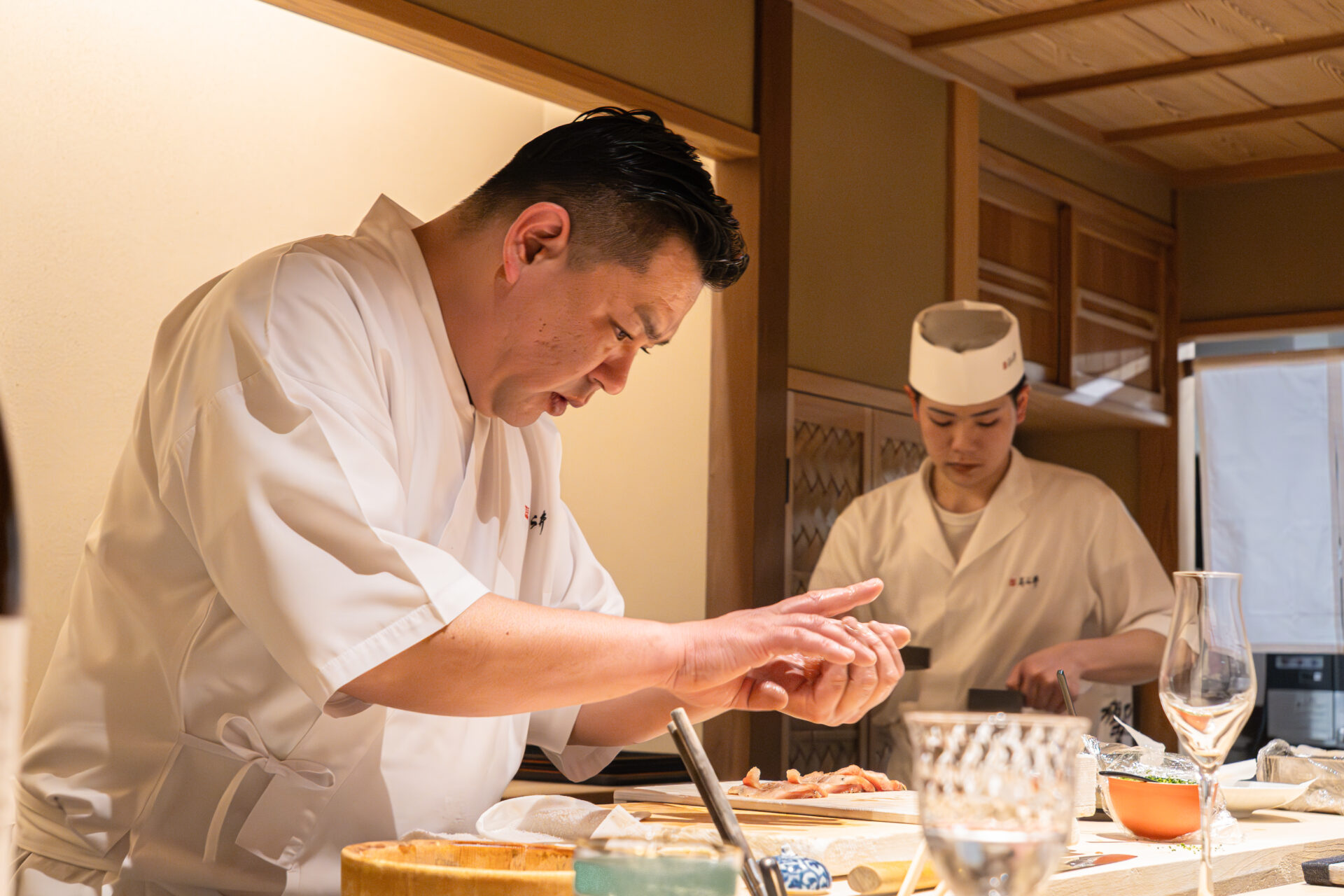
Restaurant Accolades
Aji Arai, located in Nakatsu, Oita, was awarded one Michelin star in the Michelin Guide Kumamoto & Oita 2018 Special Edition, and received a 15.5/20 rating in Gault & Millau 2024.
It also earned a Bronze in the Tabelog Award 2025, and was selected as one of the Top 100 Japanese Restaurants – WEST in 2023.
These accolades reflect the restaurant’s outstanding quality and originality in presenting Kyushu Kappo cuisine that makes full use of the region’s rich ingredients.

Dining Prelude
Exterior & Entrance
Nestled quietly in a residential neighborhood of Nakatsu, Aji Arai features a refined and tranquil exterior. A simple yet tasteful noren (fabric curtain) hangs at the entrance, subtly welcoming guests.
Inside, a serene and traditional Japanese ambiance unfolds, with both counter seating and horigotatsu-style private rooms available.
Dining Space
The dining area offers a stylish Japanese setting. There are eight counter seats, considered the best seats in the house where diners can observe the chefs at work up close.
Additionally, horigotatsu-style private rooms accommodate groups from 2 to 12 people, providing a comfortable space to enjoy a meal in privacy.
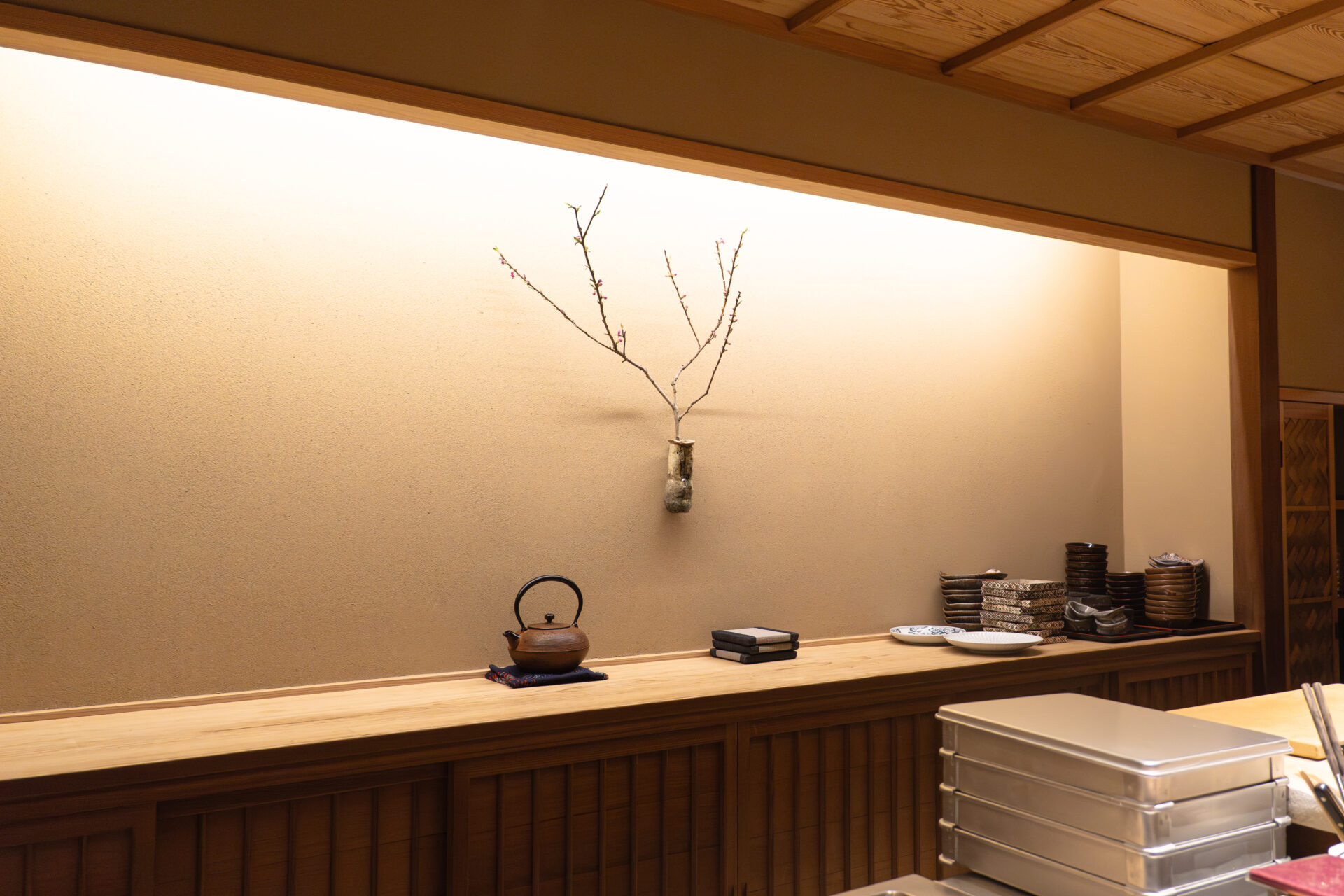
Menu Presentation
At Aji Arai, guests are served an omakase course featuring the freshest ingredients of the day. Seasonal delights from Kyushu such as extra-large abalone or Ise-ebi (spiny lobster) may appear on the menu.
In some cases, the ingredients are shown to guests before cooking, allowing them to appreciate the quality and freshness firsthand.
This thoughtful presentation enhances the sense of anticipation and makes the dining experience all the more memorable.
Dishes We Tasted
Red Sea Cucumber (Aka Namako)
The course began with Aka Namako—red sea cucumber freshly caught in Nakatsu.
This dish featured a uniquely crunchy texture and a rich aroma of the sea. It was finished with grated daikon and finely chopped scallions, whose fresh spiciness and clean flavors enhanced the umami of the sea cucumber.
Though simple, this dish allowed the ingredient’s character to shine through—an elegant and nourishing start to the meal.
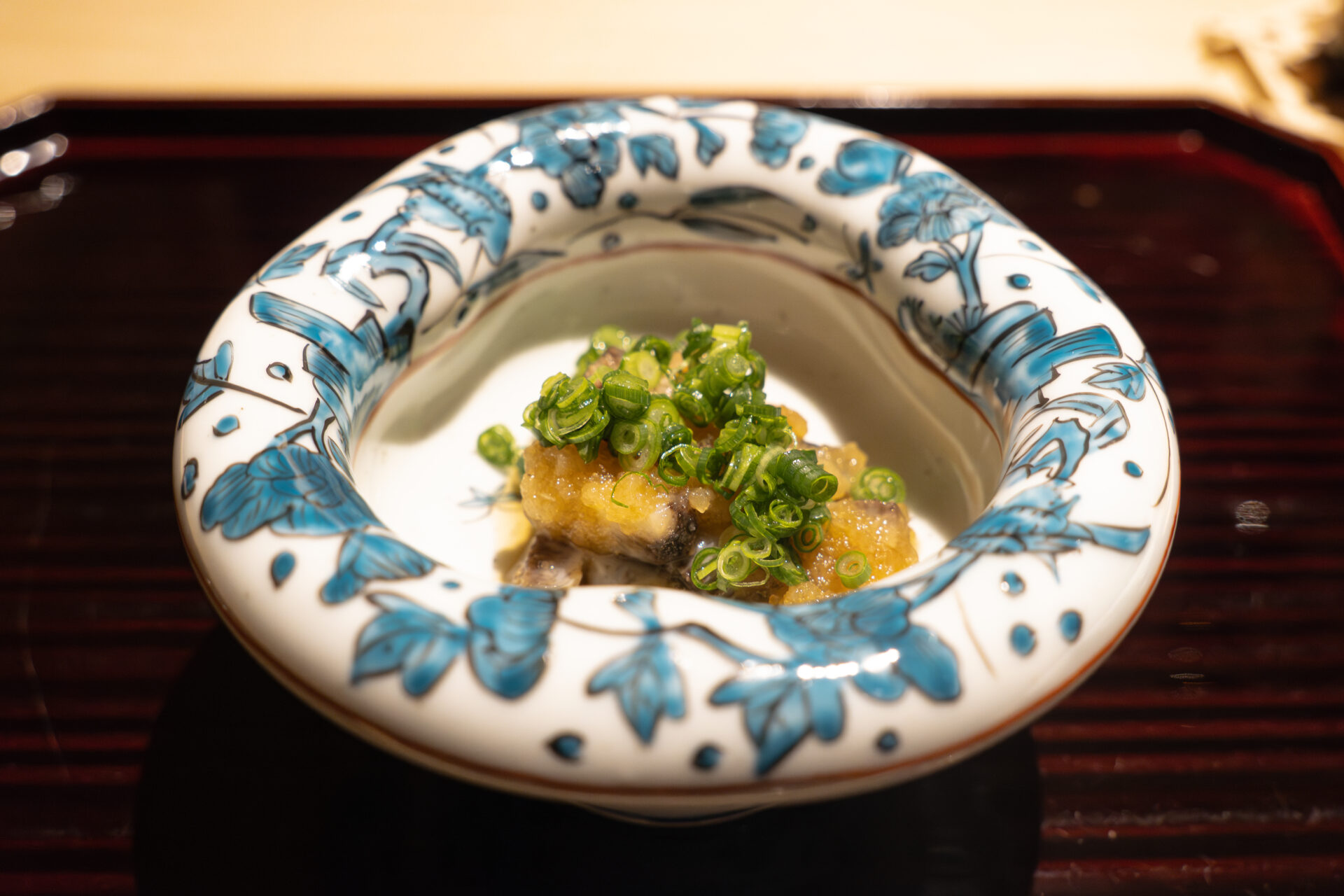
Lily Bulb Chawanmushi / Nanohana Buds / Pilot Whale Skin Sauce
A silky-smooth chawanmushi (steamed egg custard) made with sweet lily bulbs, delicately topped with the buds of nanohana (rapeseed blossoms).
Over the custard was a thick sauce made with the skin of gondo kujira (pilot whale), adding a unique gelatinous texture and deep umami. The collagen-like richness from the whale skin harmonized beautifully with the custard, offering complexity in every bite.
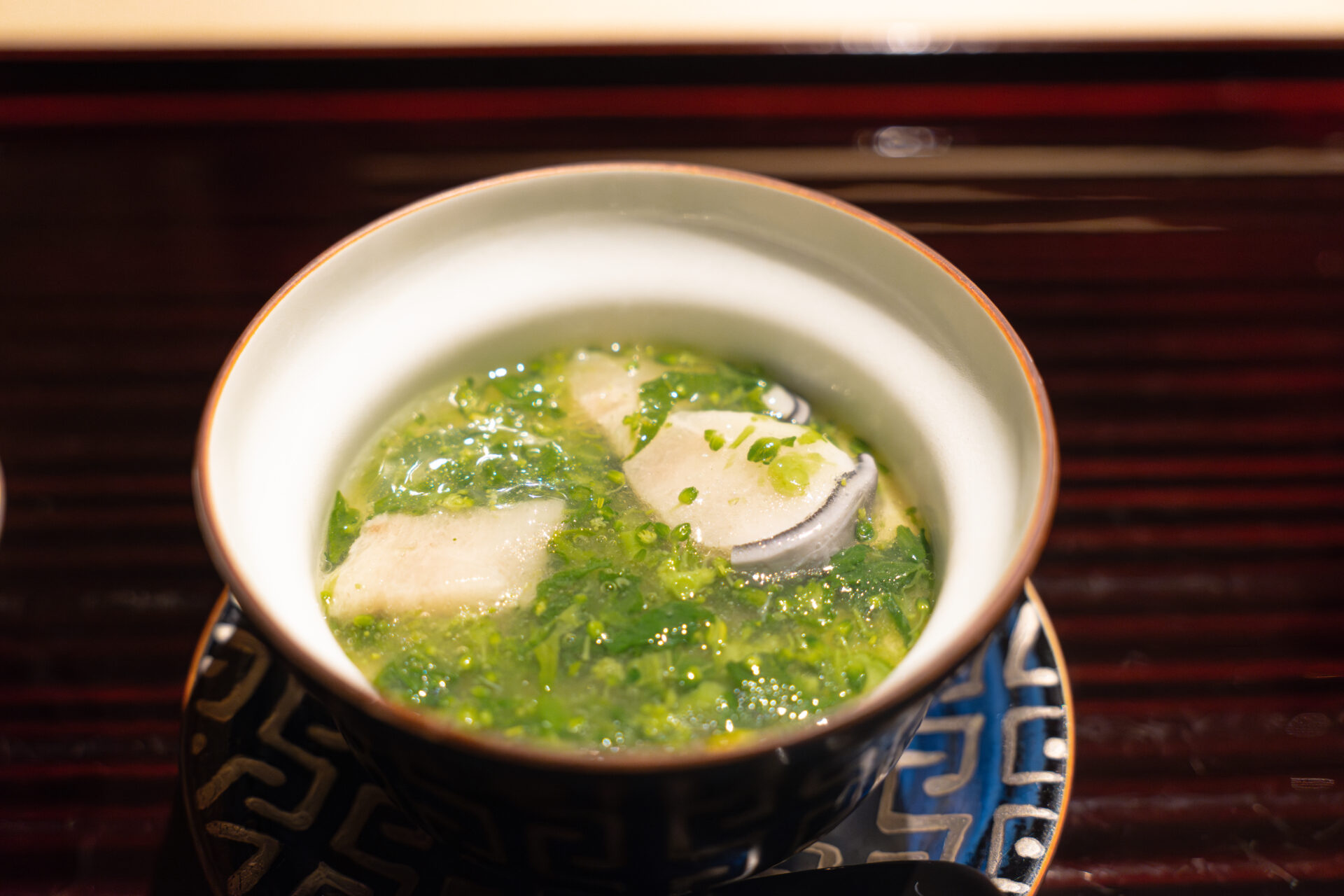
Minke Whale “Unesu” with Ginger Soy Sauce
Thinly sliced unesu—the fatty lower jaw meat of minke whale—known for its fibrous texture and rich, sweet fat.
A drizzle of ginger soy sauce brought just the right amount of heat and fragrance, balancing the depth of flavor. The richness of the fat spread gently in the mouth, while the ginger offered a clean, refreshing finish.
A straightforward yet deeply flavorful dish showcasing the unique appeal of whale meat.
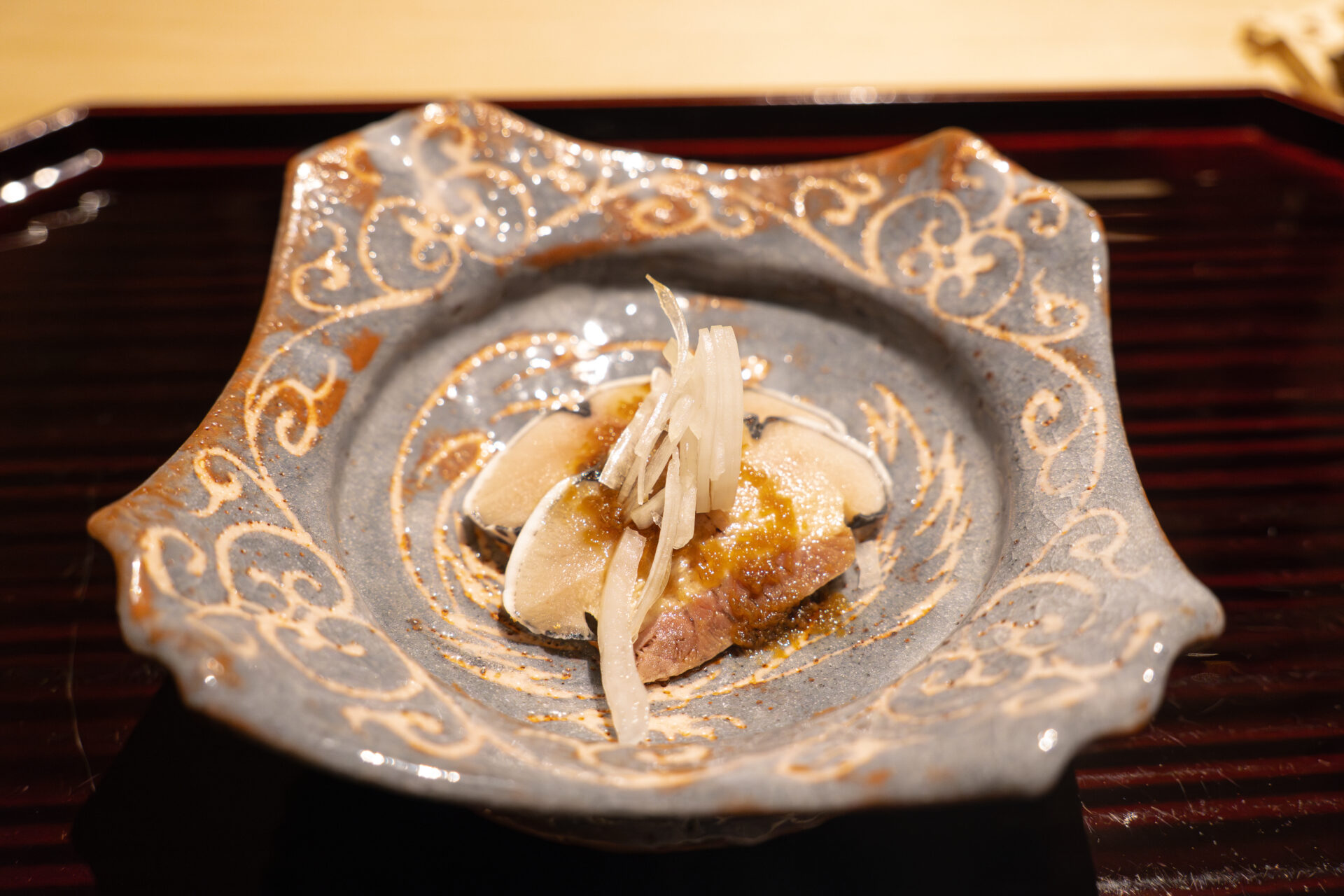
Today’s Sashimi
A luxurious selection of sashimi capturing the bounty of Oita’s coastal waters. On this day, the lineup included tora fugu(tiger pufferfish) from Oita, ishigakidai (spotted knifejaw), a 17kg kue (longtooth grouper), and local tairagi (pen shell clam).
The ishigakidai, kue, and tairagi were served in thick cuts, allowing diners to fully enjoy their texture and umami as they chewed.
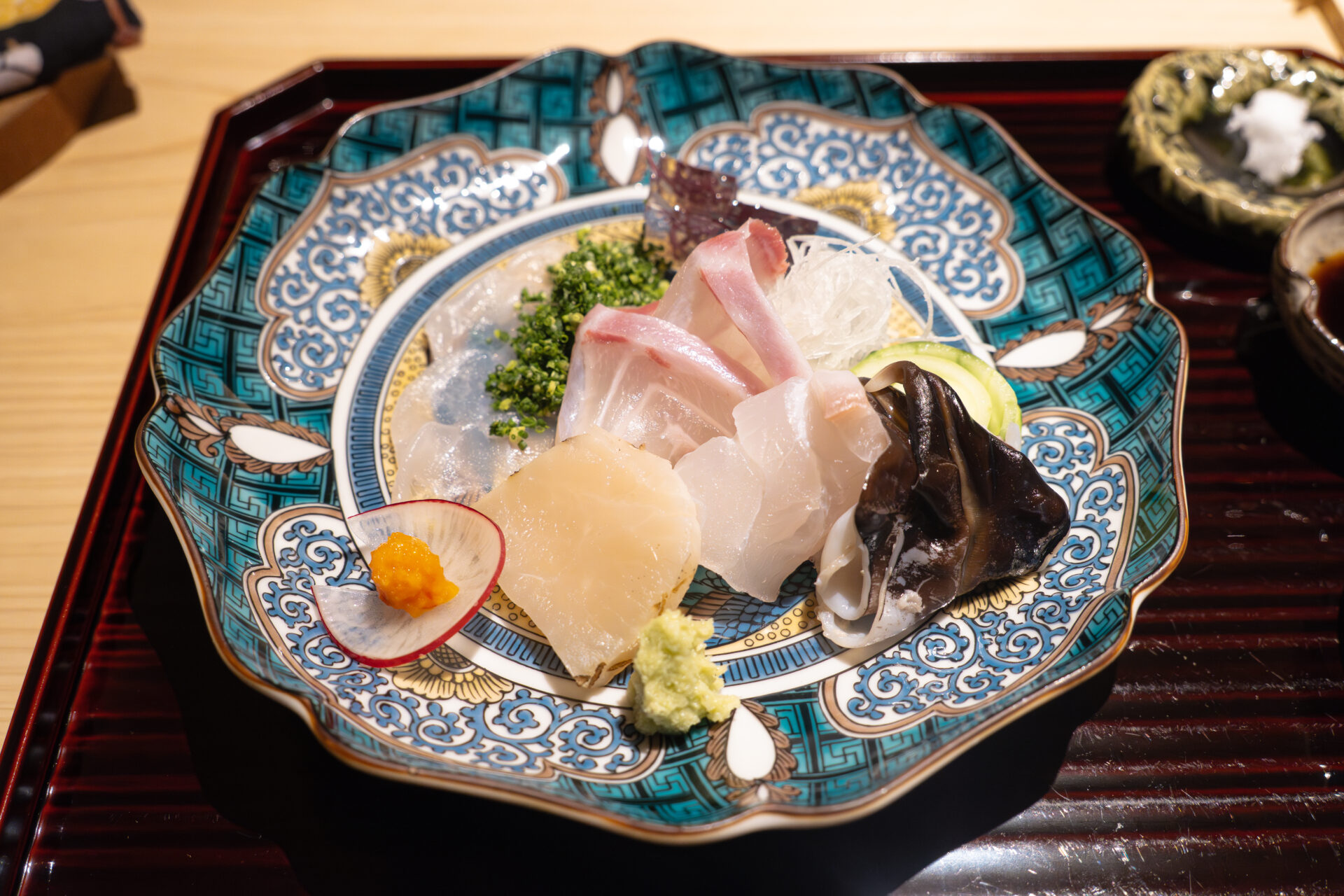
The tora fugu was first savored with a custom-blended salt to appreciate its natural flavor, followed by various condiments such as wasabi, red yuzu kosho, chopped scallions, ponzu, and soy sauce, allowing for a progression of taste variations.
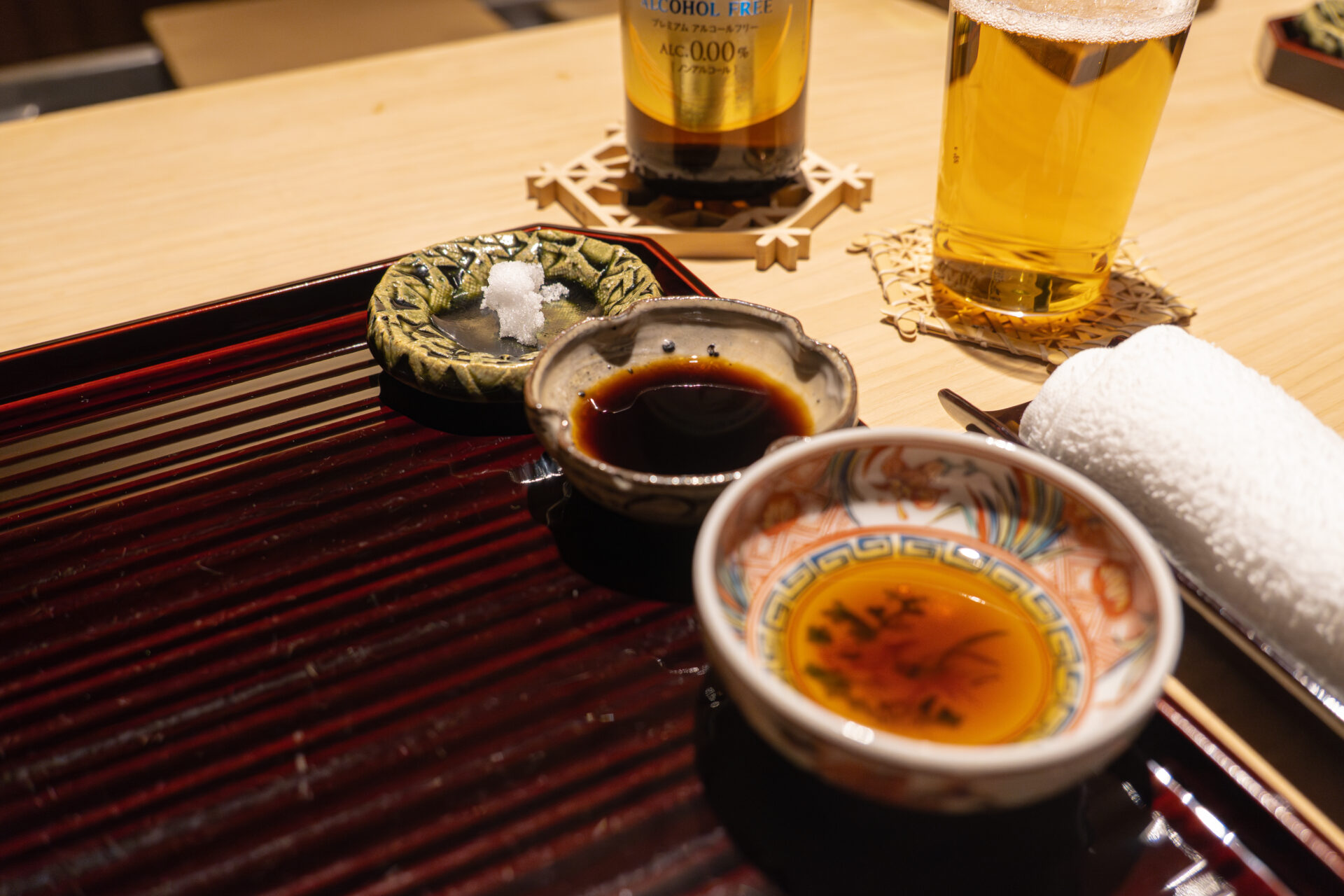
A refined and luxurious sashimi plate that highlighted the freshness of the fish and the chef’s skilled preparation.
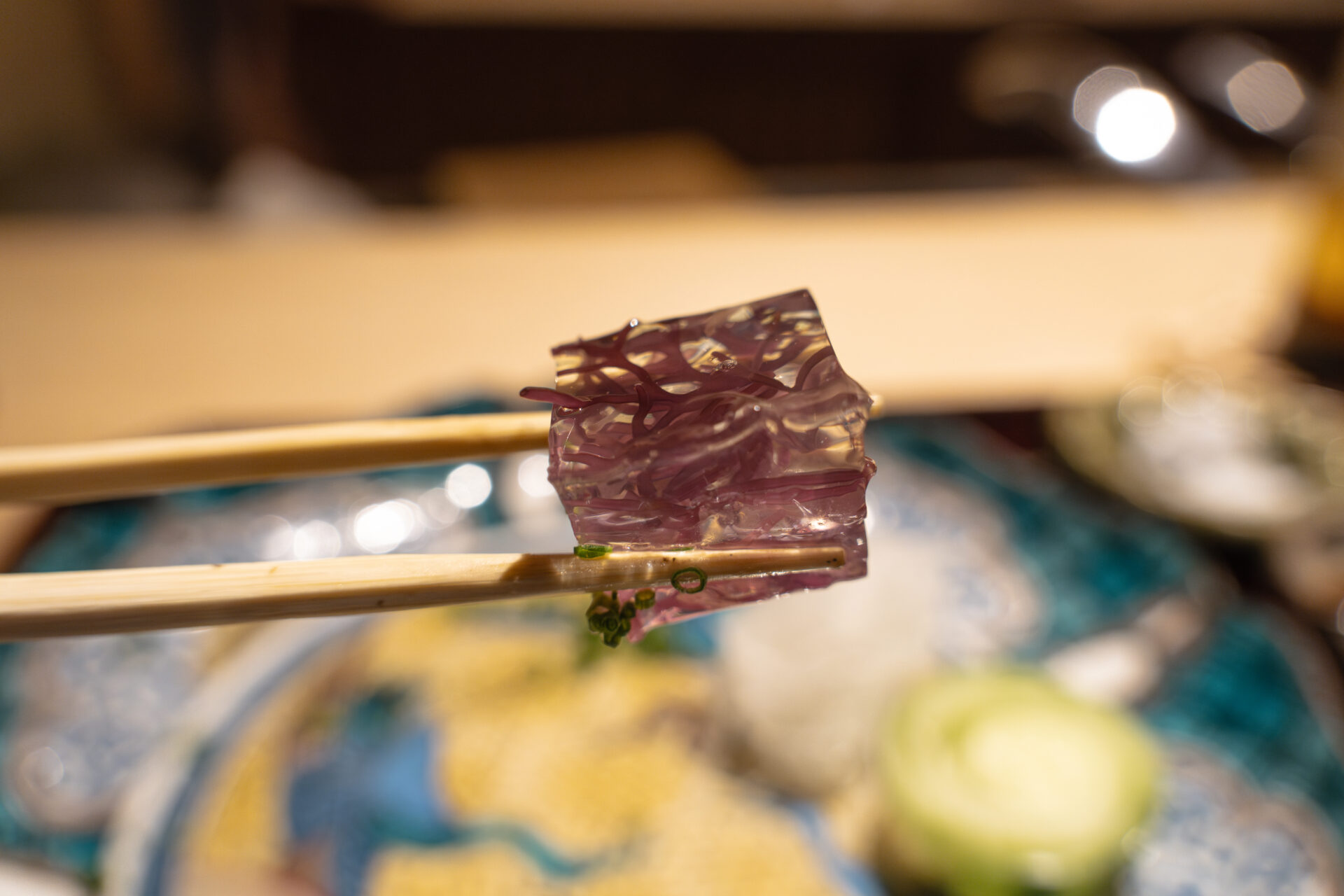
Clear Soup with Abalone and Clams
A clear broth soup featuring generous portions of abalone and hamaguri (hard clams) from Oita.
The umami from the shellfish slowly seeped into the broth, creating a deeply flavorful soup.
Seasonal vegetables like burdock root, carrot, seri (Japanese parsley), and wakame seaweed added depth and harmony, while a touch of fragrant hana yuzu provided an elegant citrus accent to finish.
A soul-warming bowl that soothed the body and spirit.
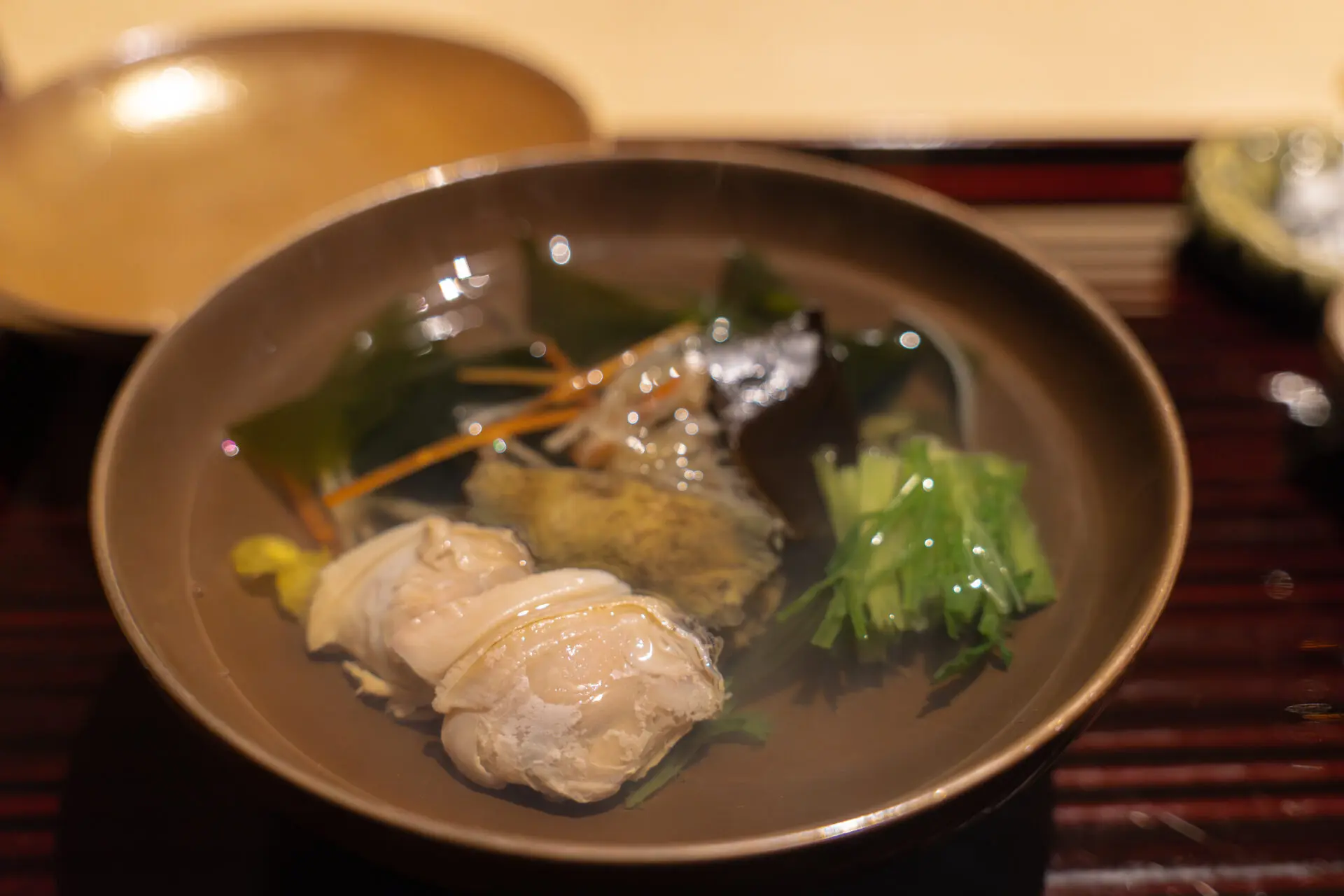
Seared Bonito (Katsuo Tataki)
A magnificent bonito weighing over 10 kilograms, caught in the waters off the Goto Islands.
Its glistening skin promised richness, a testament to the abundant fishing grounds and ideal conditions where it was caught.
Before preparation, the fish was presented to guests, heightening anticipation and appreciation for its quality.
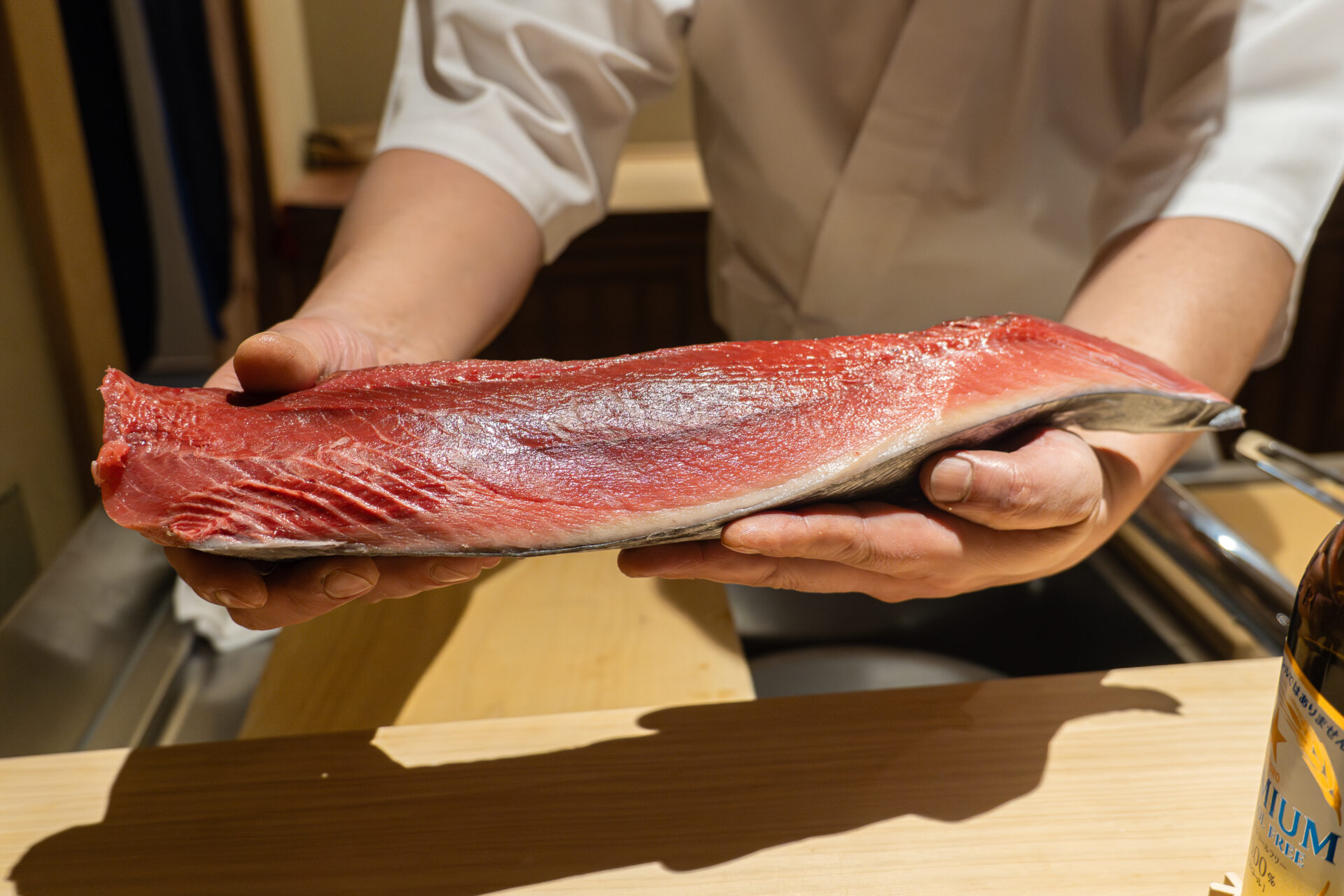
The fish was then seared using straw from a partnered rice farmer, infusing it with a smoky aroma and creating a beautifully charred surface.
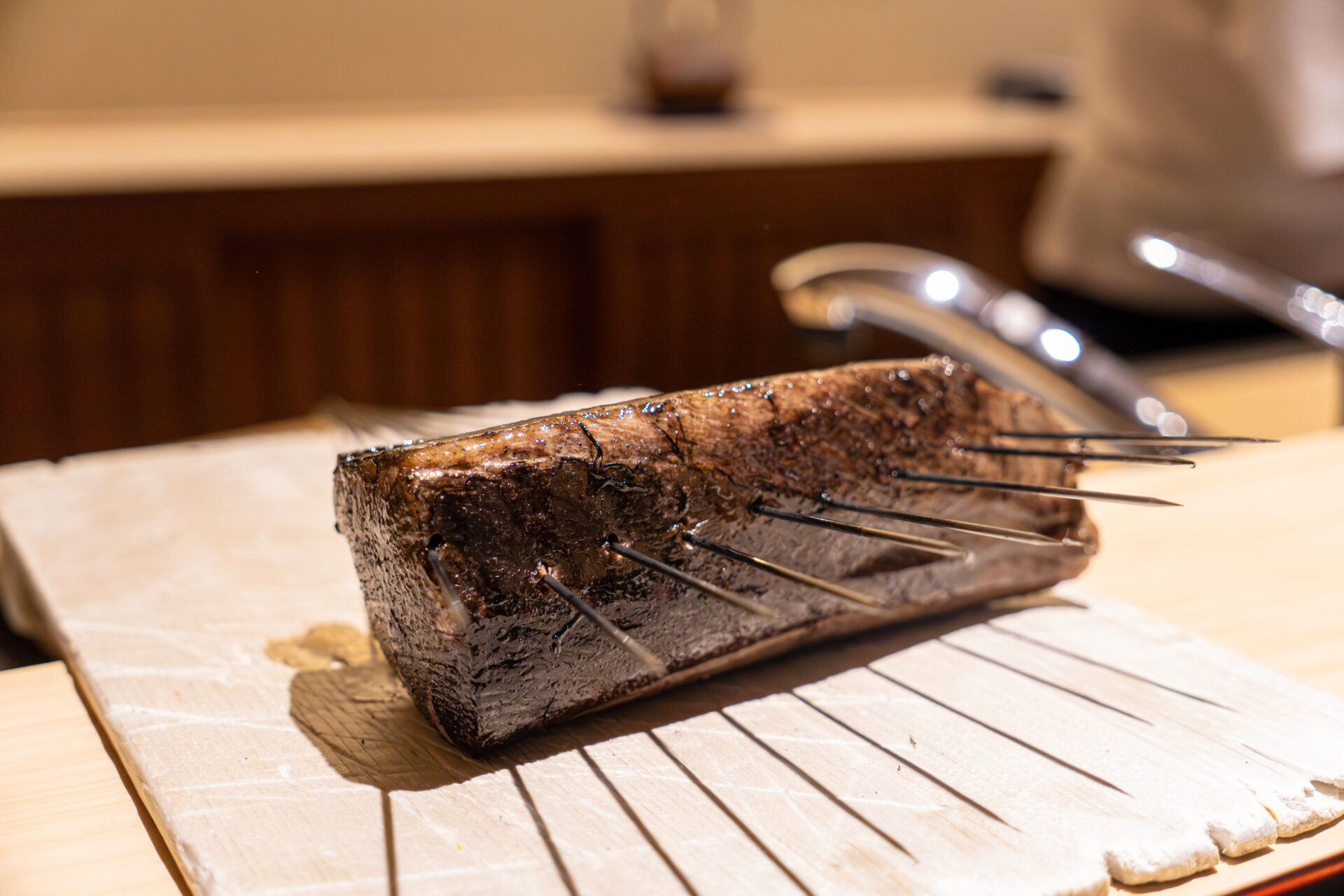
The vivid contrast of red flesh conveyed the concentration of umami even visually.
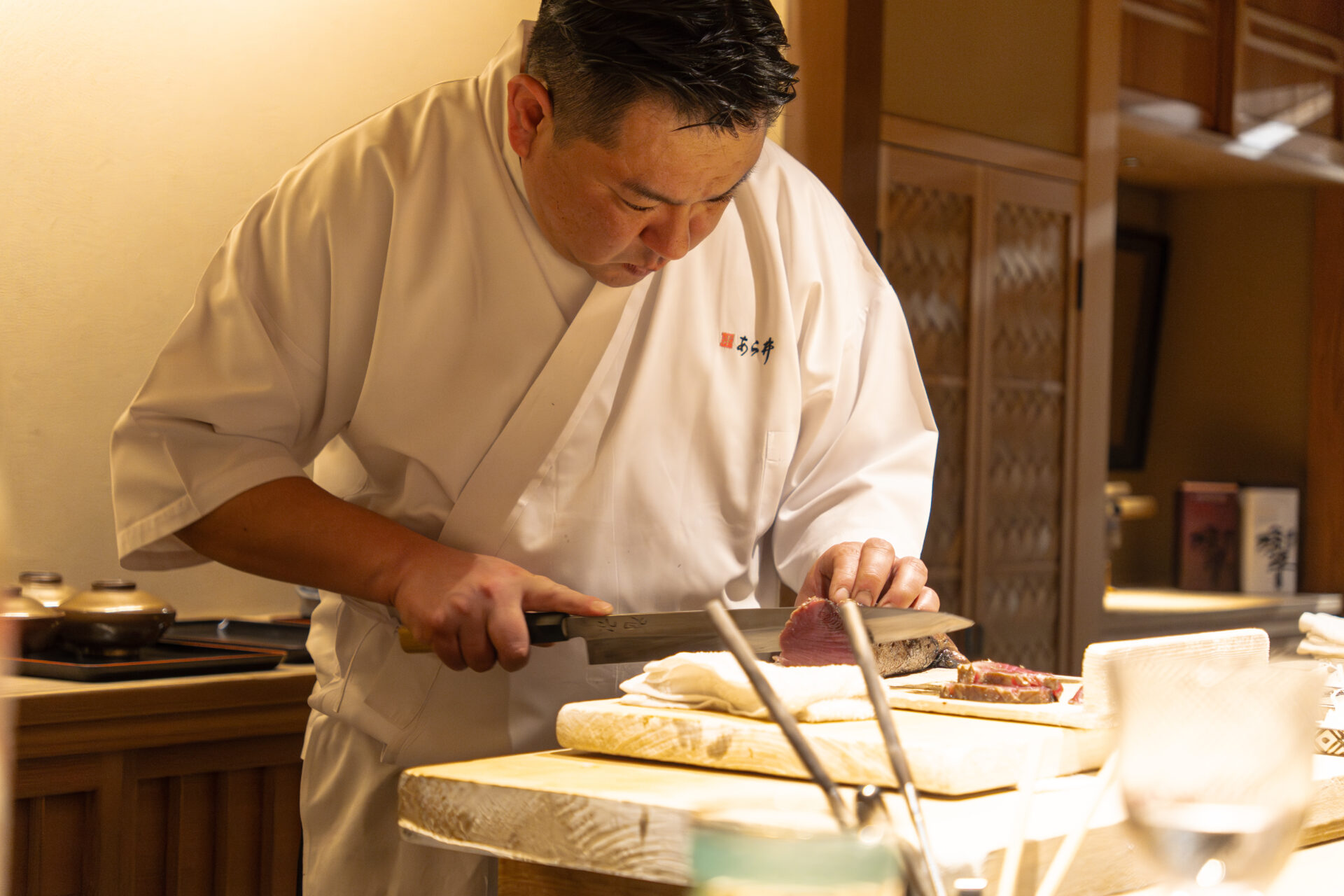
Served with banpeiyu (a large citrus fruit), the thick slices released a burst of rich, fatty flavor that flooded the palate.
The refreshing aroma and subtle acidity of the banpeiyu elevated the bonito’s richness, adding complexity and depth.
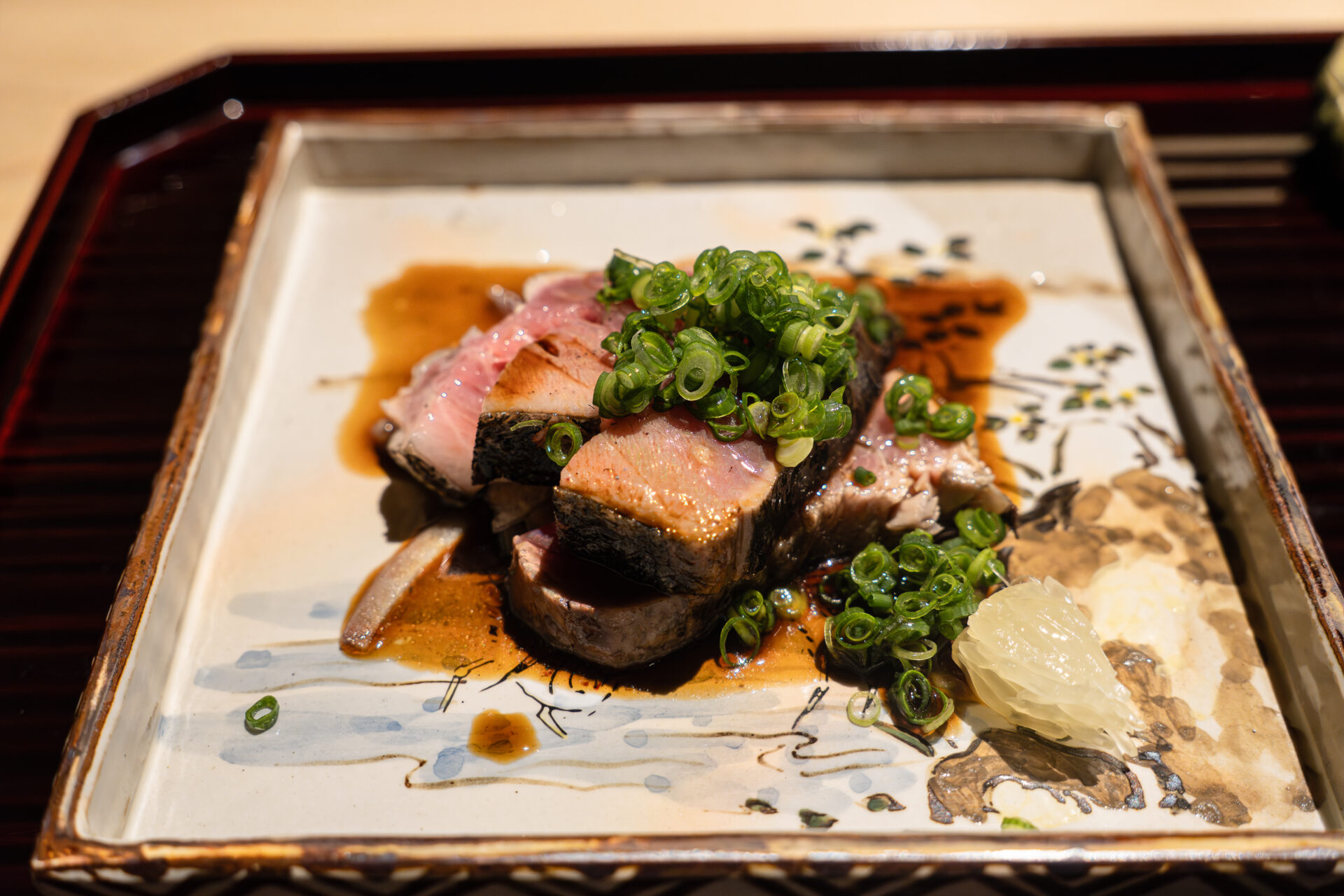
With every bite, layers of umami and citrus brightness danced together—an unforgettable dish of extraordinary presence.
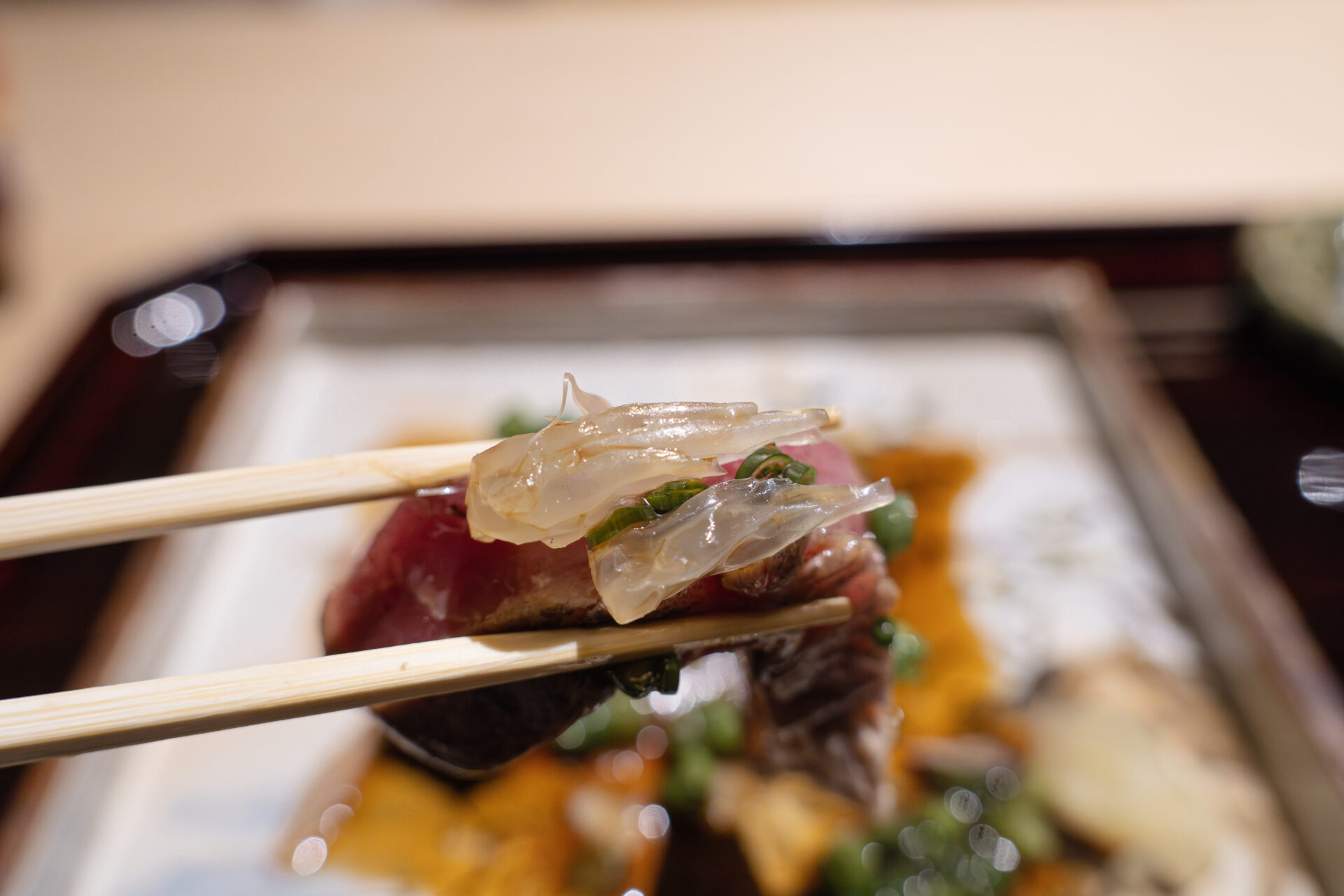
Squid and Uni
A luxurious hand-held bite featuring sweet aori ika (bigfin reef squid) from Oita topped with a generous mound of rich uni (sea urchin) from Hagi, wrapped in aromatic nori seaweed.
The crisp texture of the nori gave way to the creamy sweetness of the squid and the intense umami of the uni, creating a decadent mouthful with every bite.
This special item was served directly by hand, allowing diners to savor the flavors at peak freshness in a fleeting, exquisite moment.
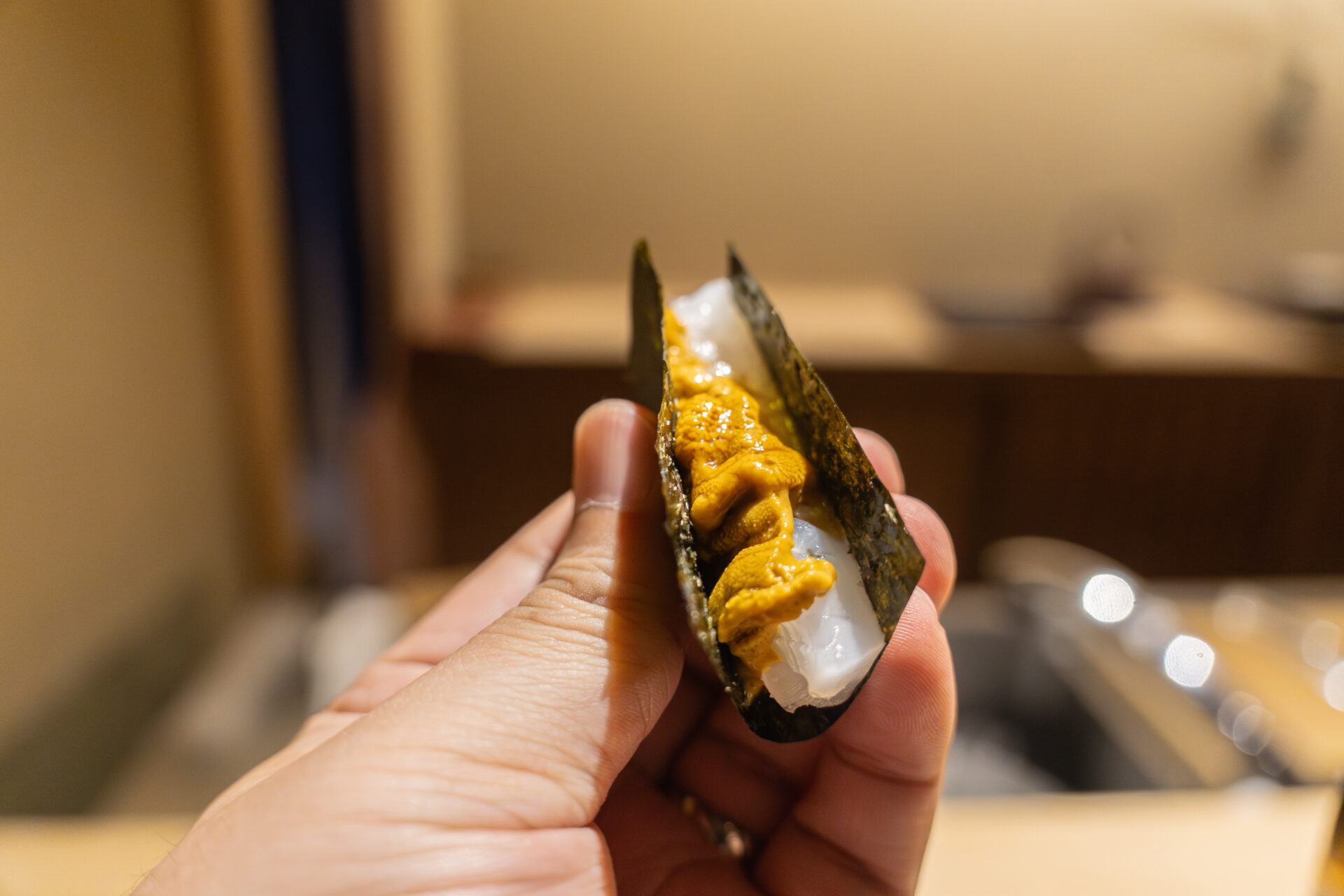
Nanohana and Karasumi
A palate cleanser crafted from the stalks of nanohana used earlier in the meal, repurposed thoughtfully to reduce waste.
The crisp texture and gentle bitterness of the nanohana reset the palate, providing a smooth transition to the next dish.
Rich, salty karasumi (bottarga) added depth, resulting in a dish that was both simple and sophisticated.
A clever use of ingredients that gave meaning to the meal’s flow while showcasing seasonal sensitivity.
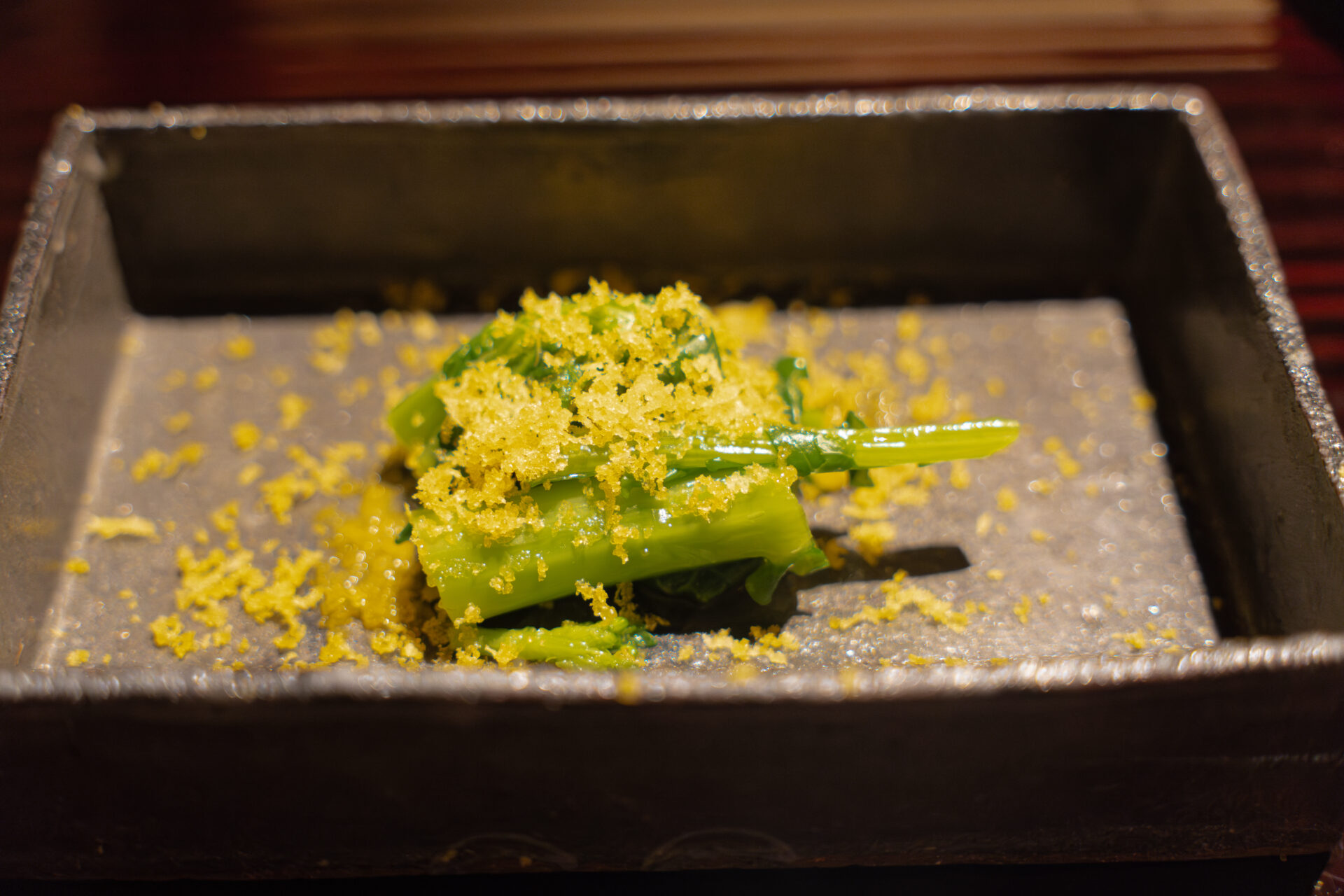
Sushi
Bonito Sushi
Chef Arai brought out a wooden ohitsu filled with vinegared rice and began shaping sushi by hand.
He used a cut from the same bonito served earlier as tataki, this time untouched by flame, served as nigiri.
The lean meat had a tender texture, and the generous marbling of fat released intense umami that spread across the palate. Each bite melted on the tongue, perfectly balanced with the rice’s subtle acidity. A well-crafted piece that let the robust flavor of bonito shine.
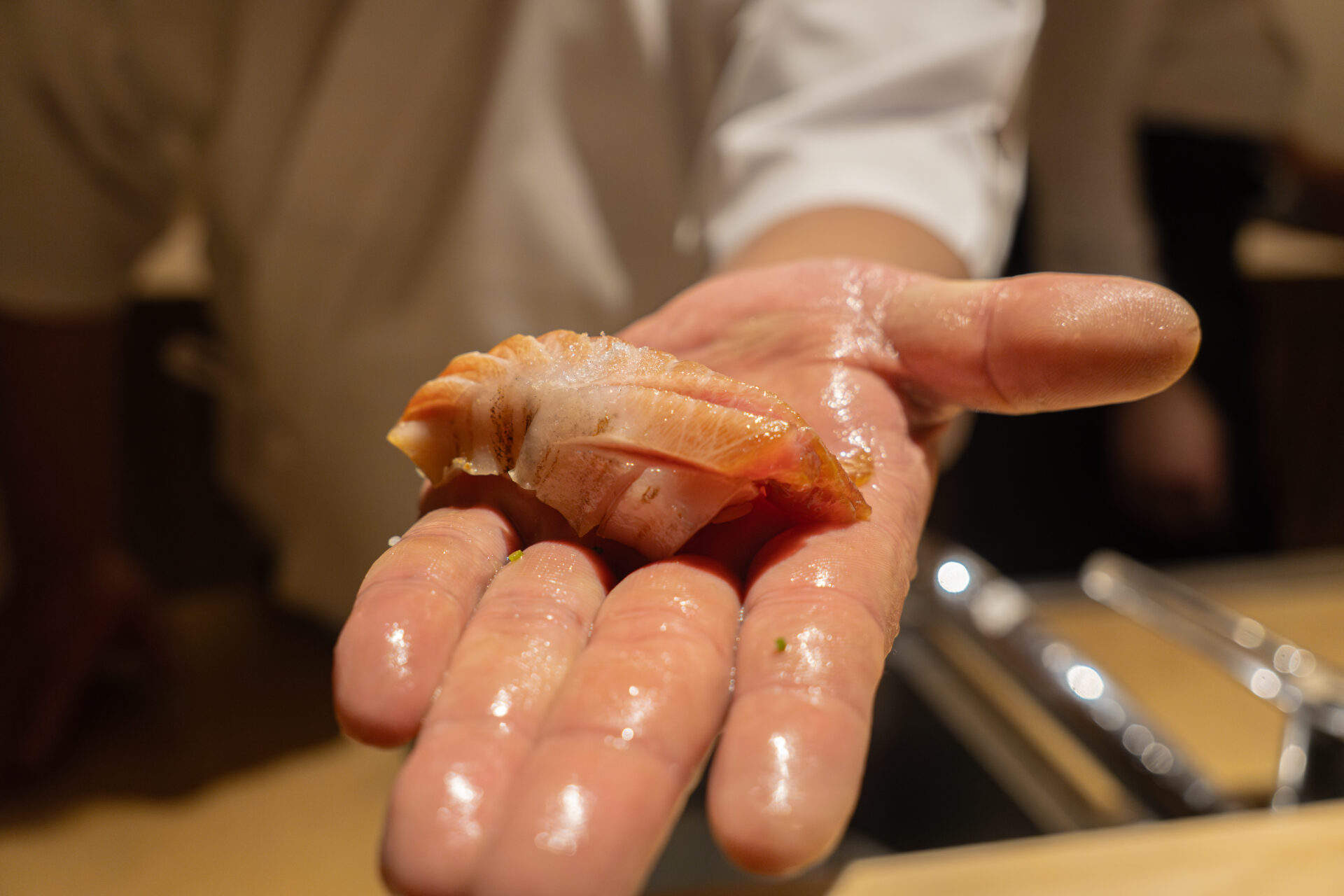
A surprise second serving came when the chef offered an extra piece with a smile.
The richness of the fish and the harmony with the rice were just as striking as the first time—perhaps even more. It was a lucky moment that brought both joy and deep appreciation.
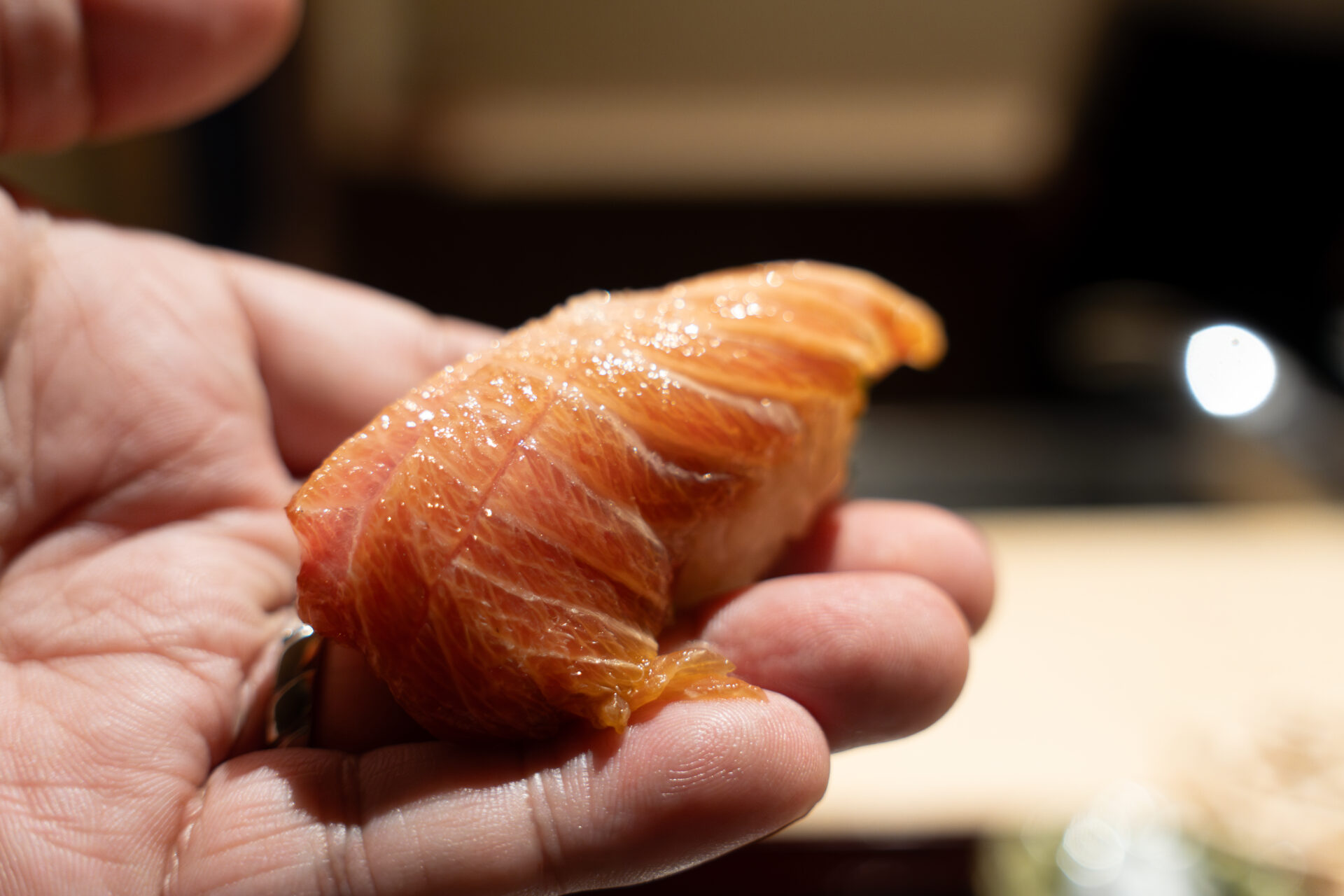
Marinated & Seared Tuna Sushi
This piece featured tuna that had been marinated in soy sauce and lightly seared—an original technique devised by the chef.
The soy marinade enhanced the fish’s flavor, while the searing added a fragrant, toasty surface.
With each bite, the savoriness of the sear and the depth of the tuna’s flavor unfolded and melded beautifully with the rice.
It’s a method so unique that even other sushi chefs often ask about it. A signature bite that showed Chef Arai’s mastery of aging and heat control—both rare and memorable.
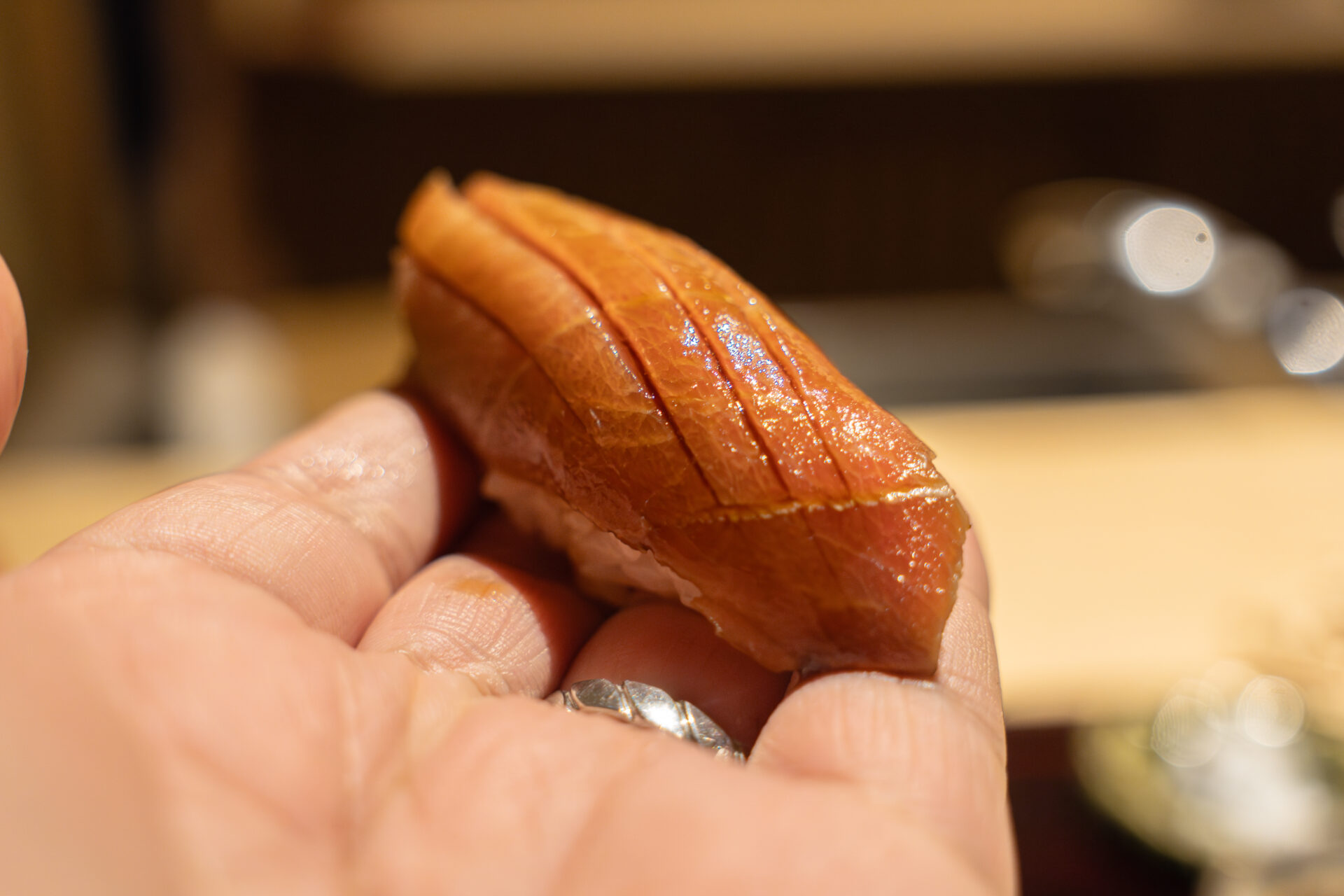
Deep-Fried Oyster
A plump oyster from Buzen, fried to crisp perfection, was served with a house-made tartar sauce that included pickled cucumber (nukazuke), matsumae-zuke (a seasoned kelp and seafood mixture), and whole-grain mustard.
The slight tang from the pickles, the deep umami of the kelp, and the zing of the mustard created a tartar with a bold, layered flavor unlike any standard version.
The richness of the oyster paired exquisitely with the complexity of the sauce—a thoughtfully crafted dish that elevated the humble kaki furai.
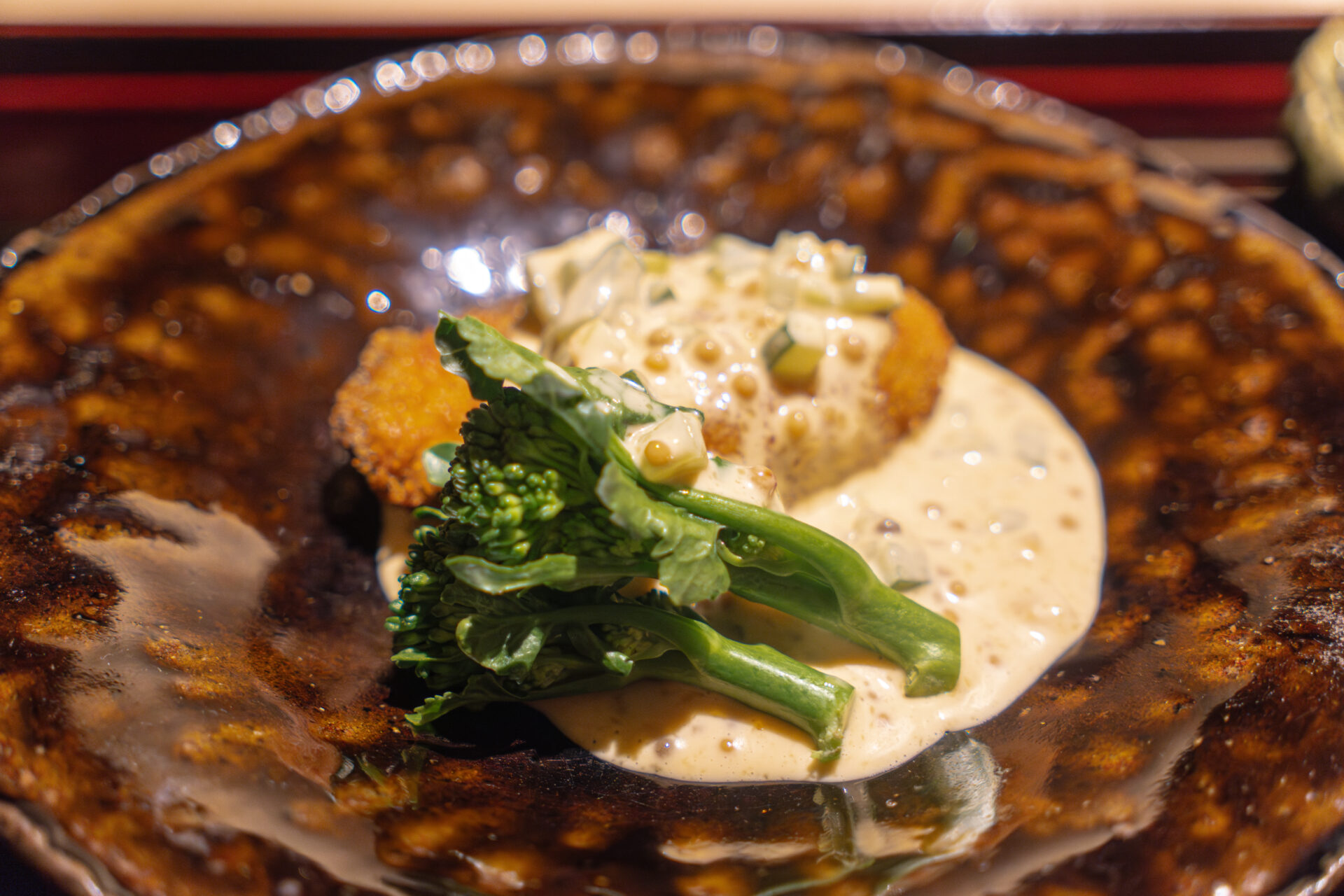
Grilled Shirako
Next came grilled shirako (milt), creamy and luxuriously rich. The outside was seared to a light crisp, while the inside remained meltingly soft and smooth.
Beneath the shirako was a subtly vinegared rice base hidden within a delicate sauce. This tiny amount of rice added just enough acidity to cut through the richness and lend depth.
Topped with sesame and aonori (green laver seaweed) from the Yamakuni River, the dish gained both nutty and oceanic notes.
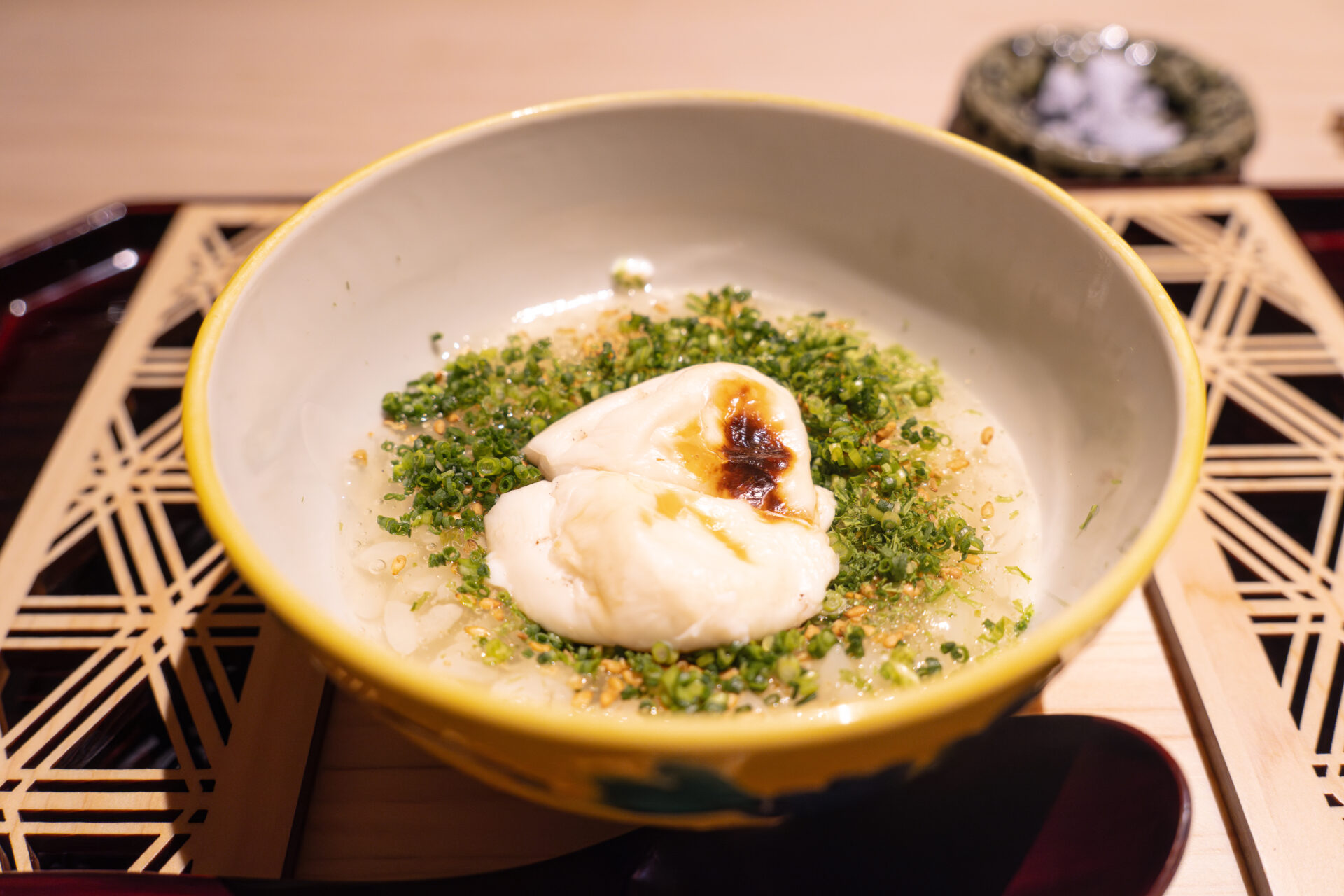
The interplay of the creamy shirako, vinegared rice, and fragrant seaweed created a delicate yet deeply memorable dish.
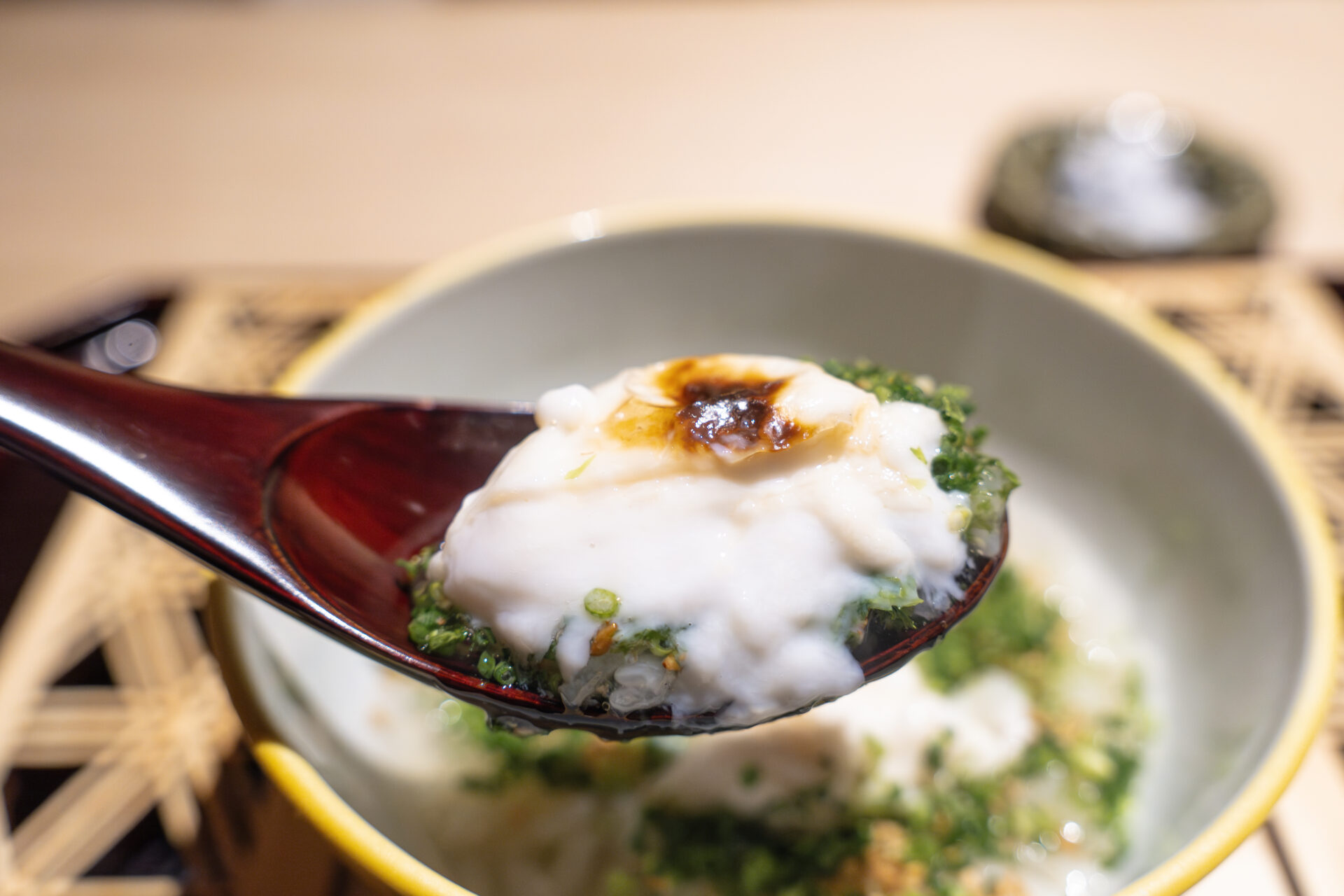
Beef Shabu-shabu
Beautifully marbled local beef from Nakatsu was thinly sliced by the chef and gently swirled in a steaming hotpot right before our eyes.
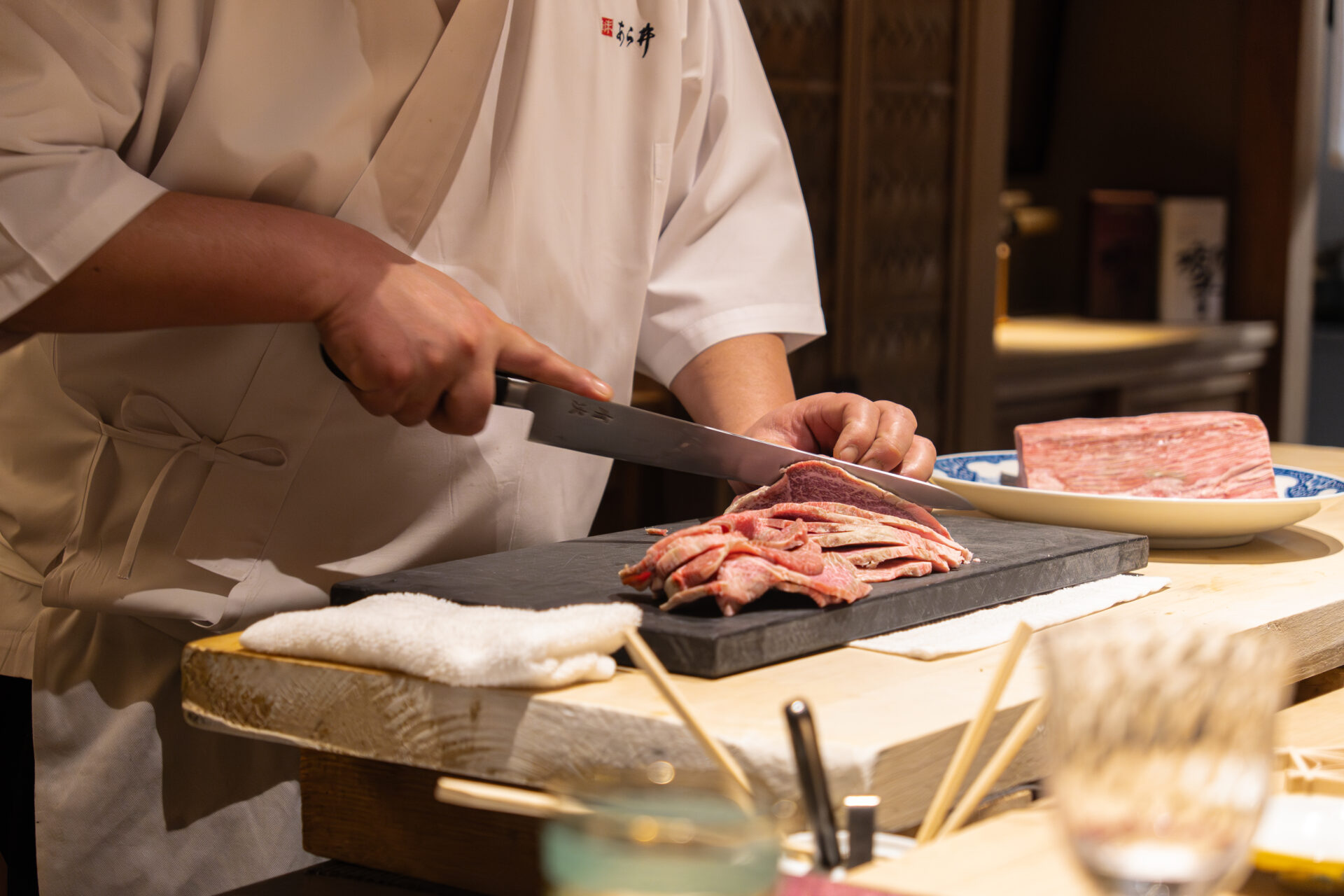
The moment the meat changed color in the broth brought a thrill of anticipation.
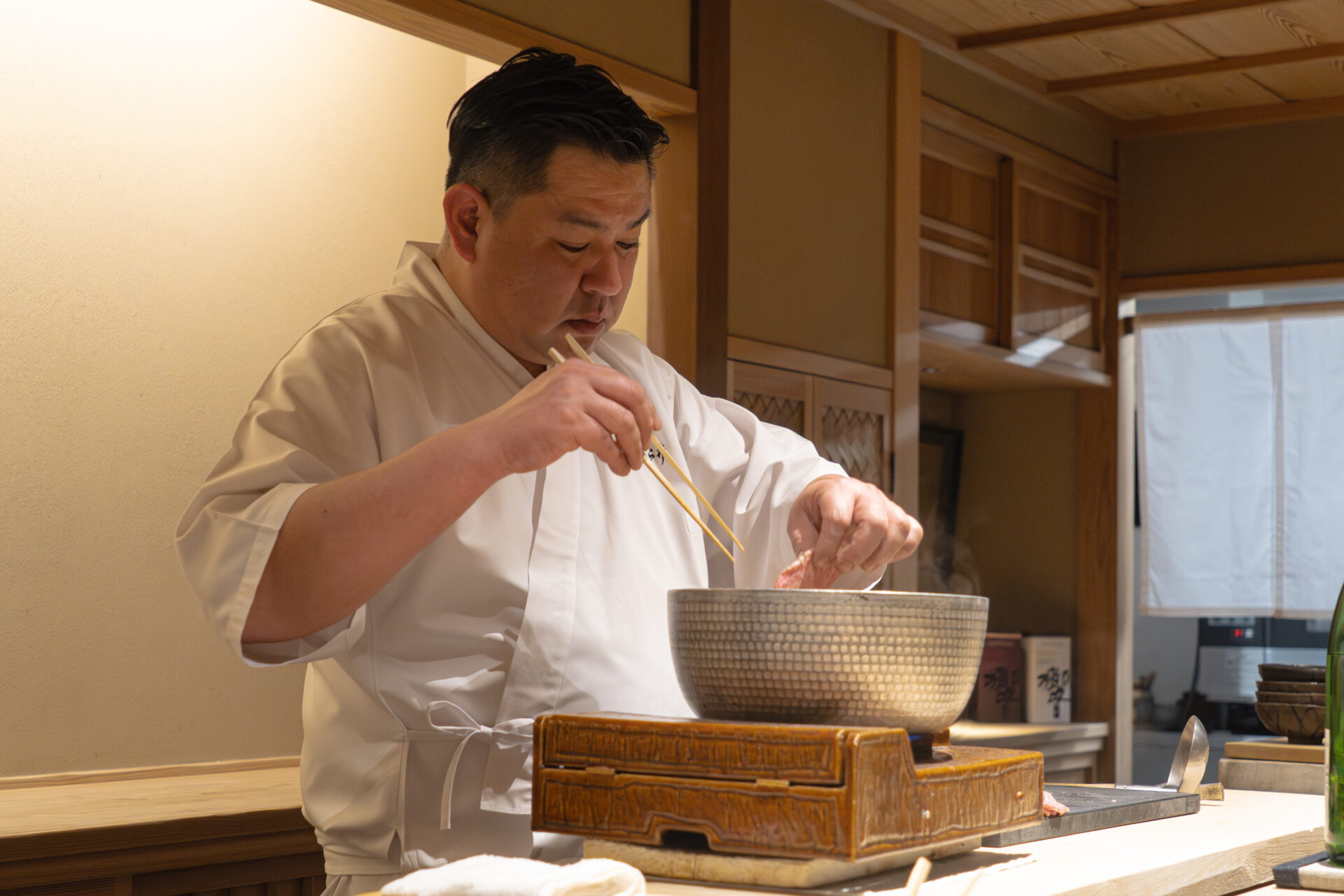
Tender and luscious, the beef absorbed the savory broth and released a wave of umami with every bite.
The soup, now enriched with the flavor of the beef, carried the aroma of the dashi and offered comforting depth in every sip.
A luxurious dish that showcased the full flavor of premium Japanese beef.
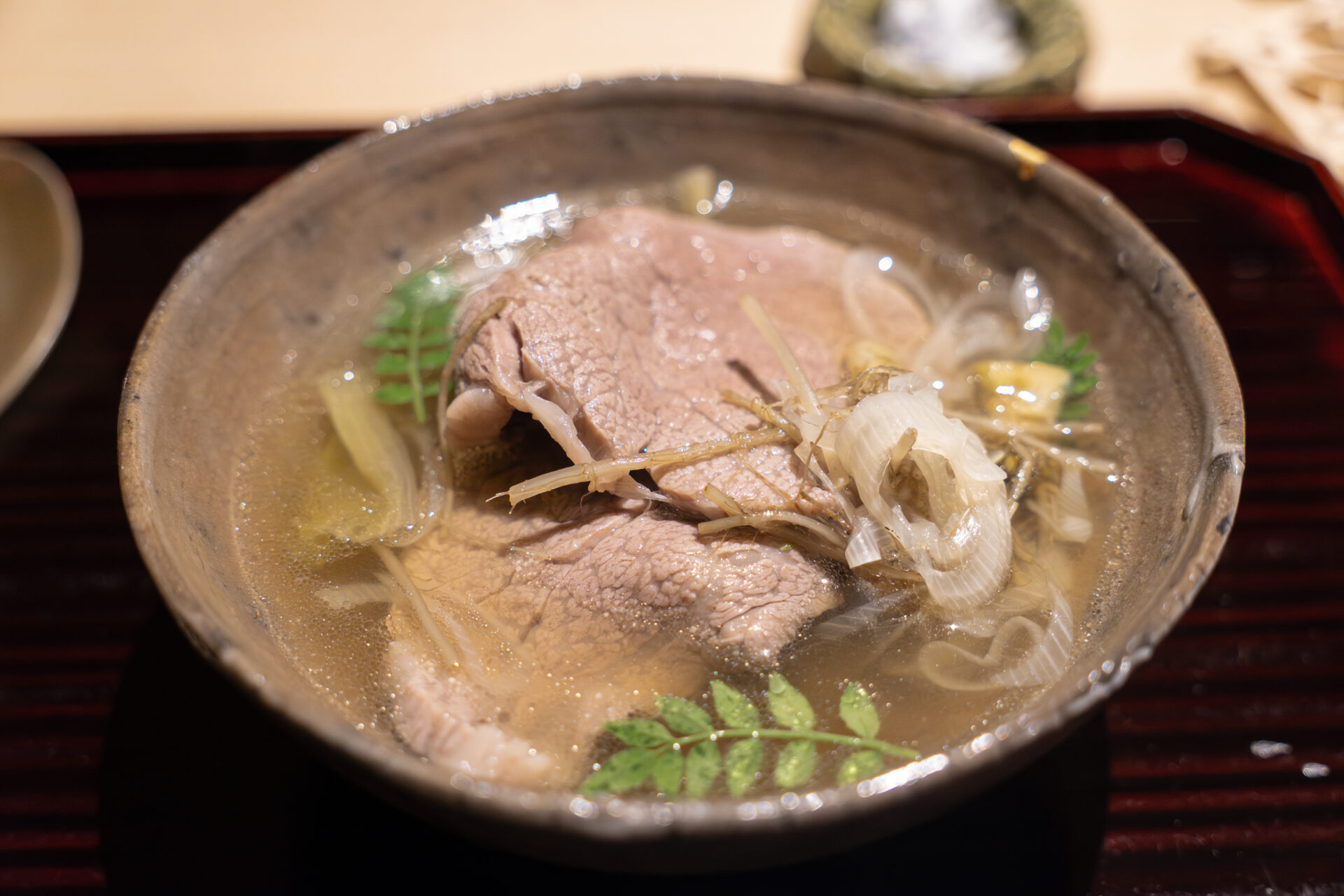
Clay Pot Rice
To close the meal, freshly cooked rice was presented in an earthenware pot.
As the lid was lifted, a fragrant cloud of steam rose, carrying the warm aroma of just-cooked rice.
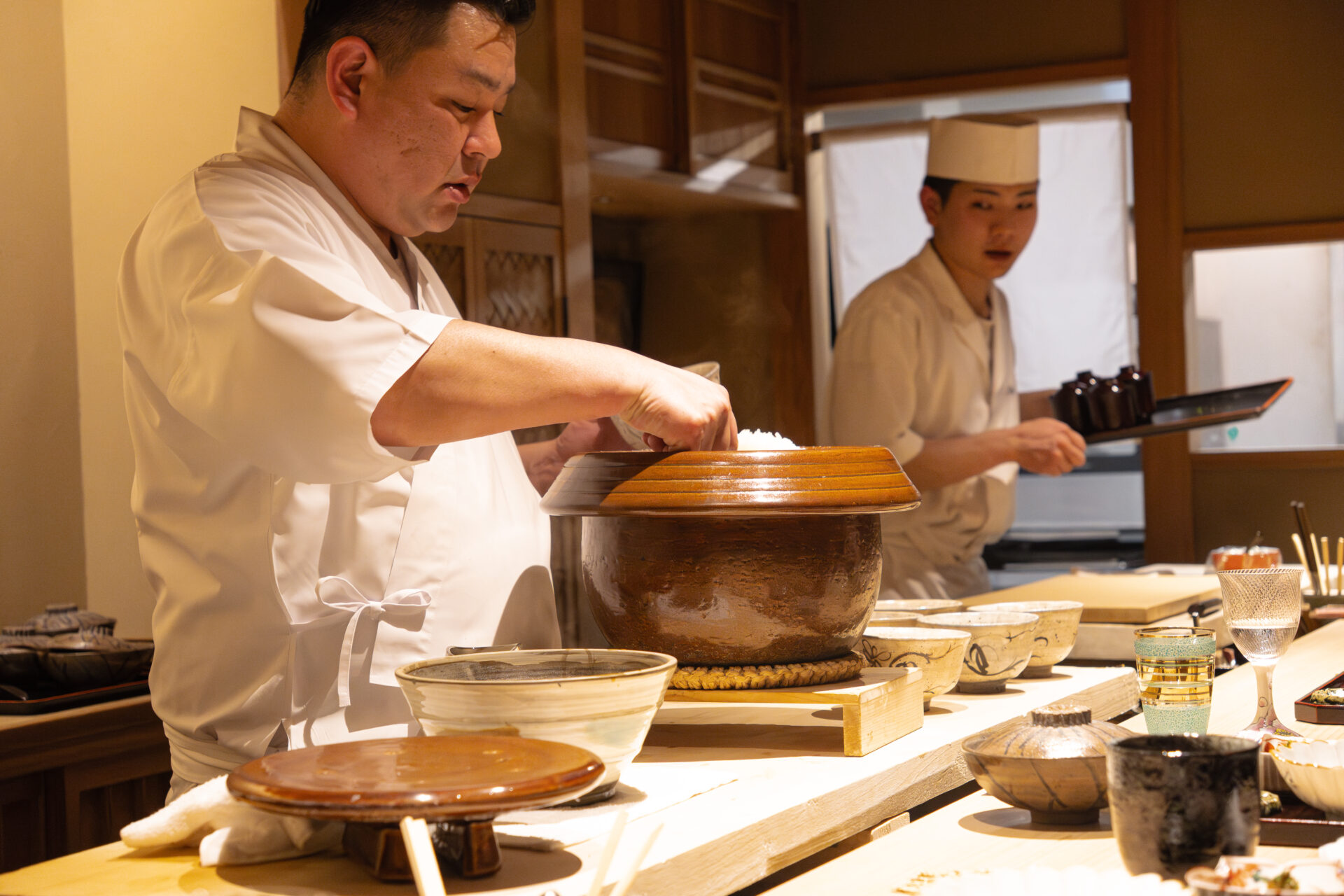
Each glossy grain was perfectly plump and distinct—simple yet deeply satisfying.
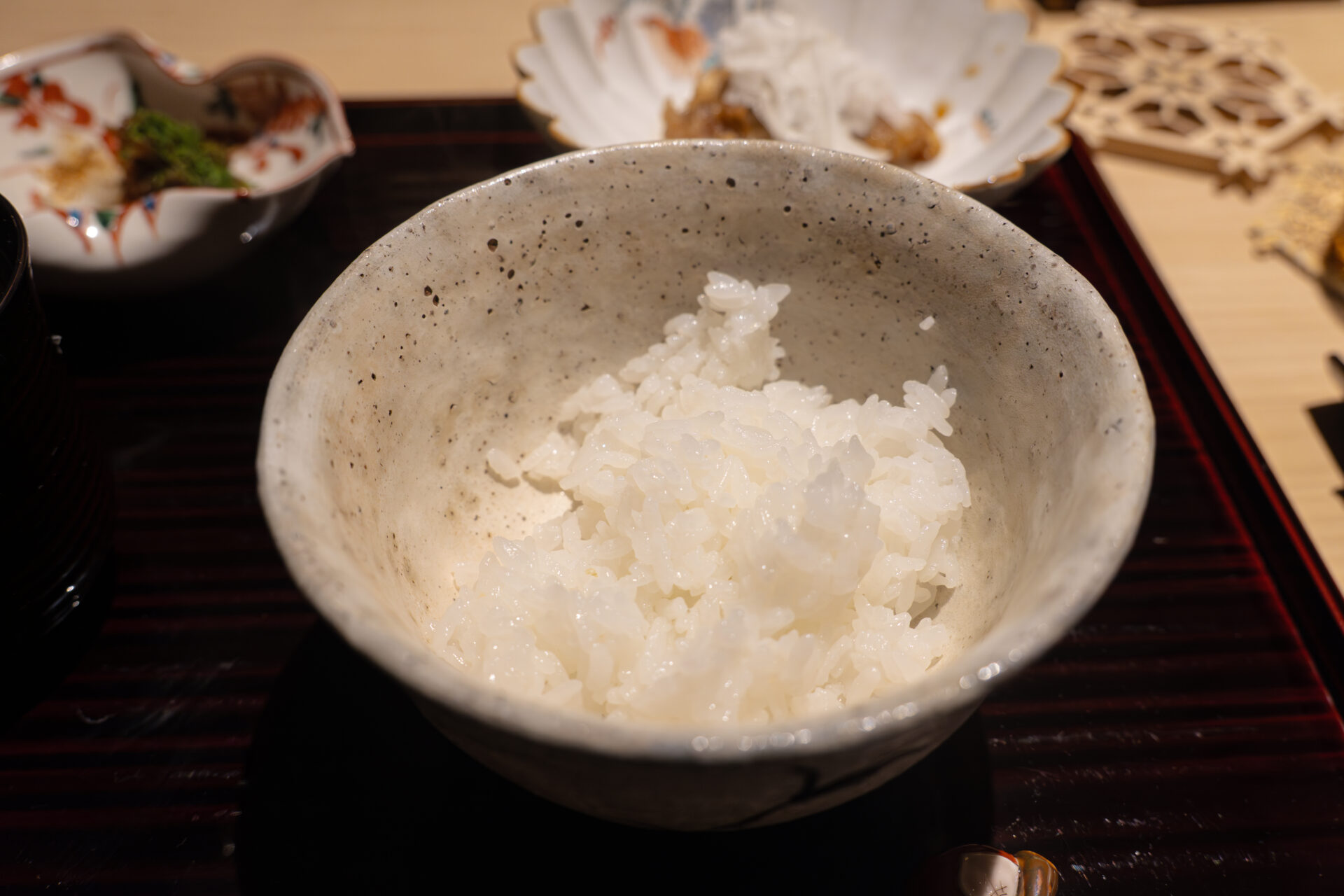
Deep-Fried Butterfish (Managatsuo)
A golden-fried fillet of managatsuo (butterfish), tender and moist beneath a light, crispy coating.
Thinly sliced onions were piled on top, adding a fresh crunch and gentle spiciness.
Underneath was a house-made sauce that enhanced the flavor of the fish while keeping the finish clean.
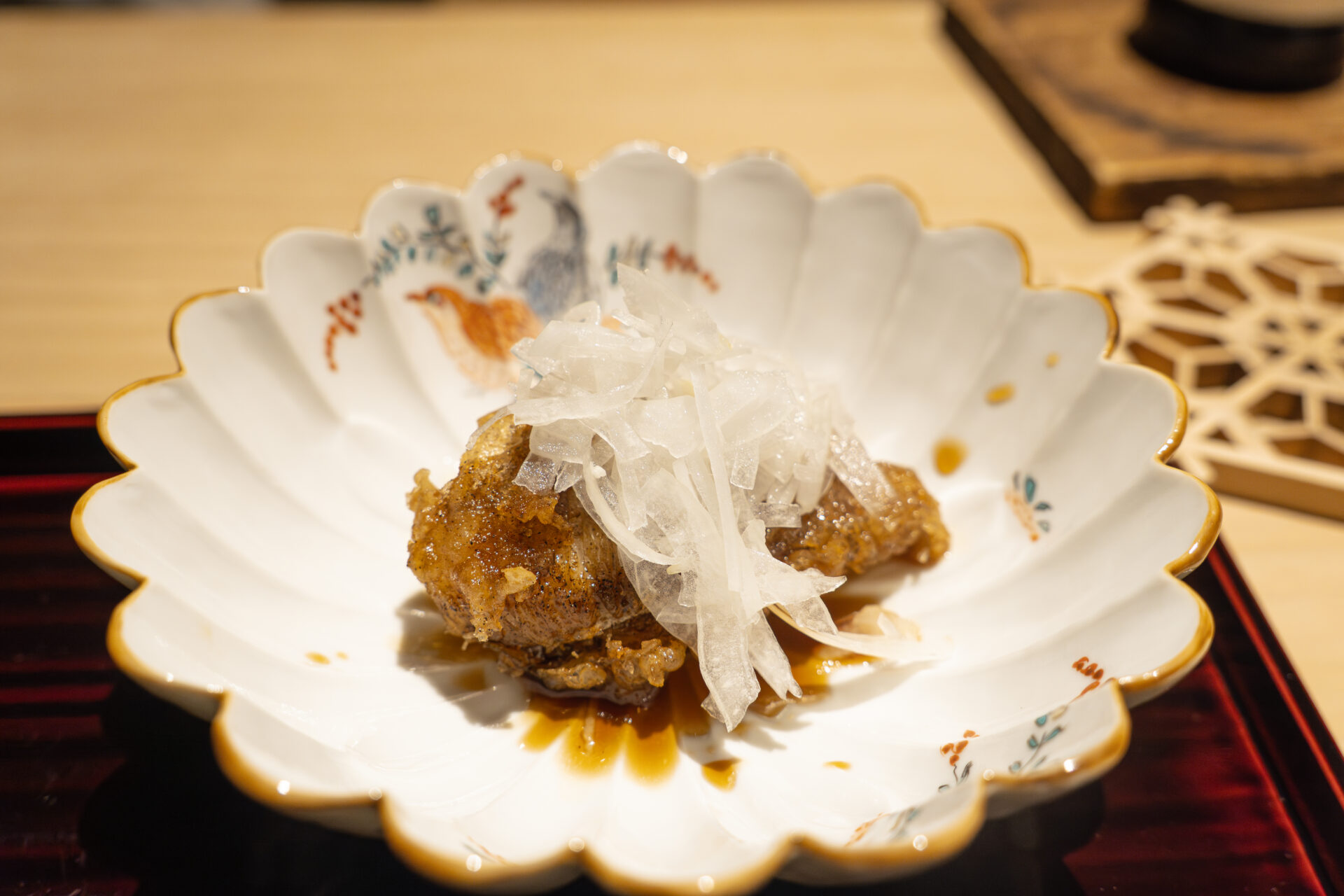
Miso Soup
Chef Arai believes miso soup should be generously packed with ingredients, and his version reflected that philosophy.
Made with fugu ara (pufferfish trimmings) and various other ingredients, the broth was rich and full of umami.
The miso was deeply flavorful yet velvety smooth. Each sip delivered warming comfort and nourishment, seeping into the body and soul.
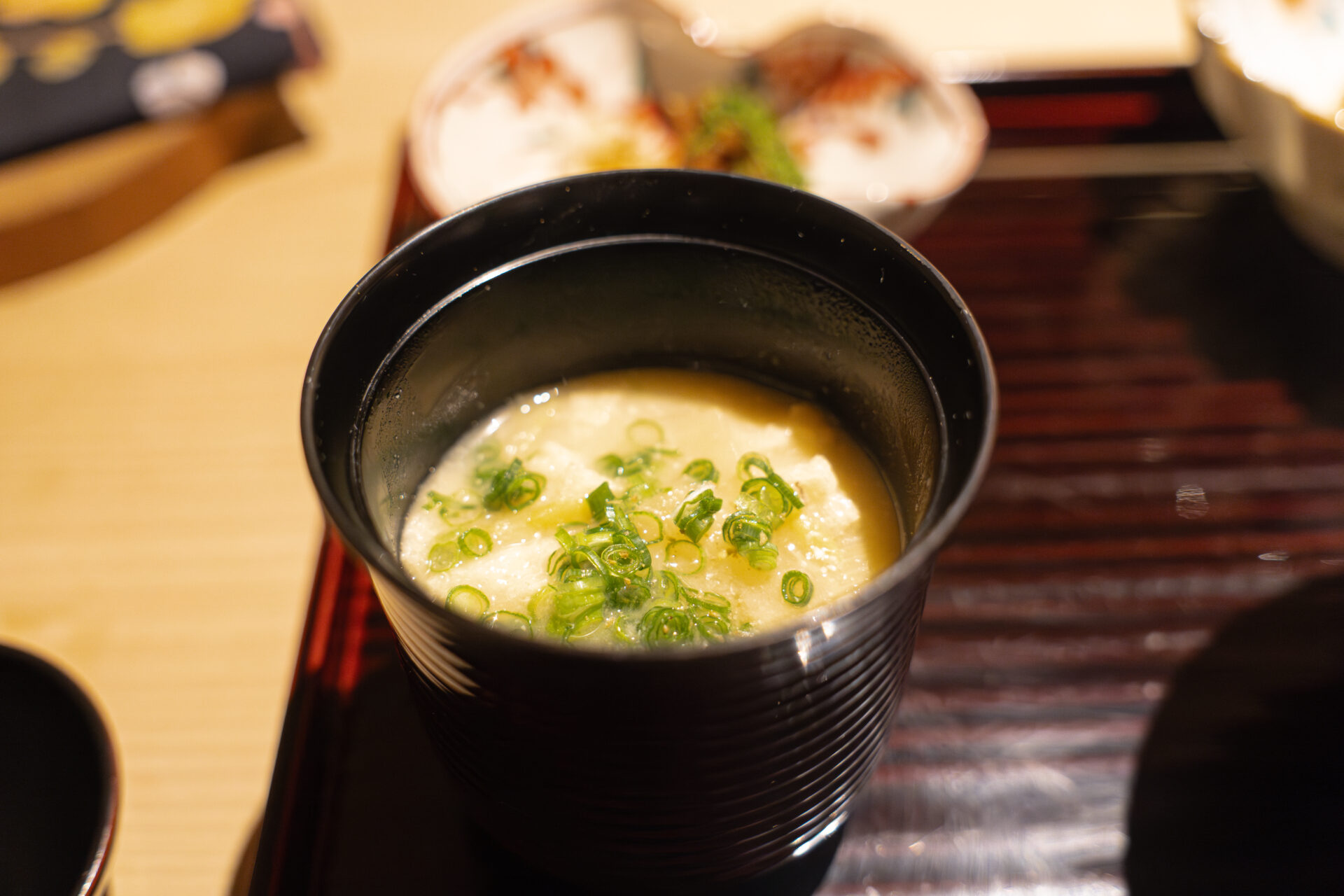
A Final Indulgence
A decadent finishing touch: placing the managatsuo cutlet atop the clay pot rice to create a makeshift tendon-style bowl.
The richness of the fish, the freshly steamed rice, and the flavorful sauce made for an irresistibly satisfying last bite.
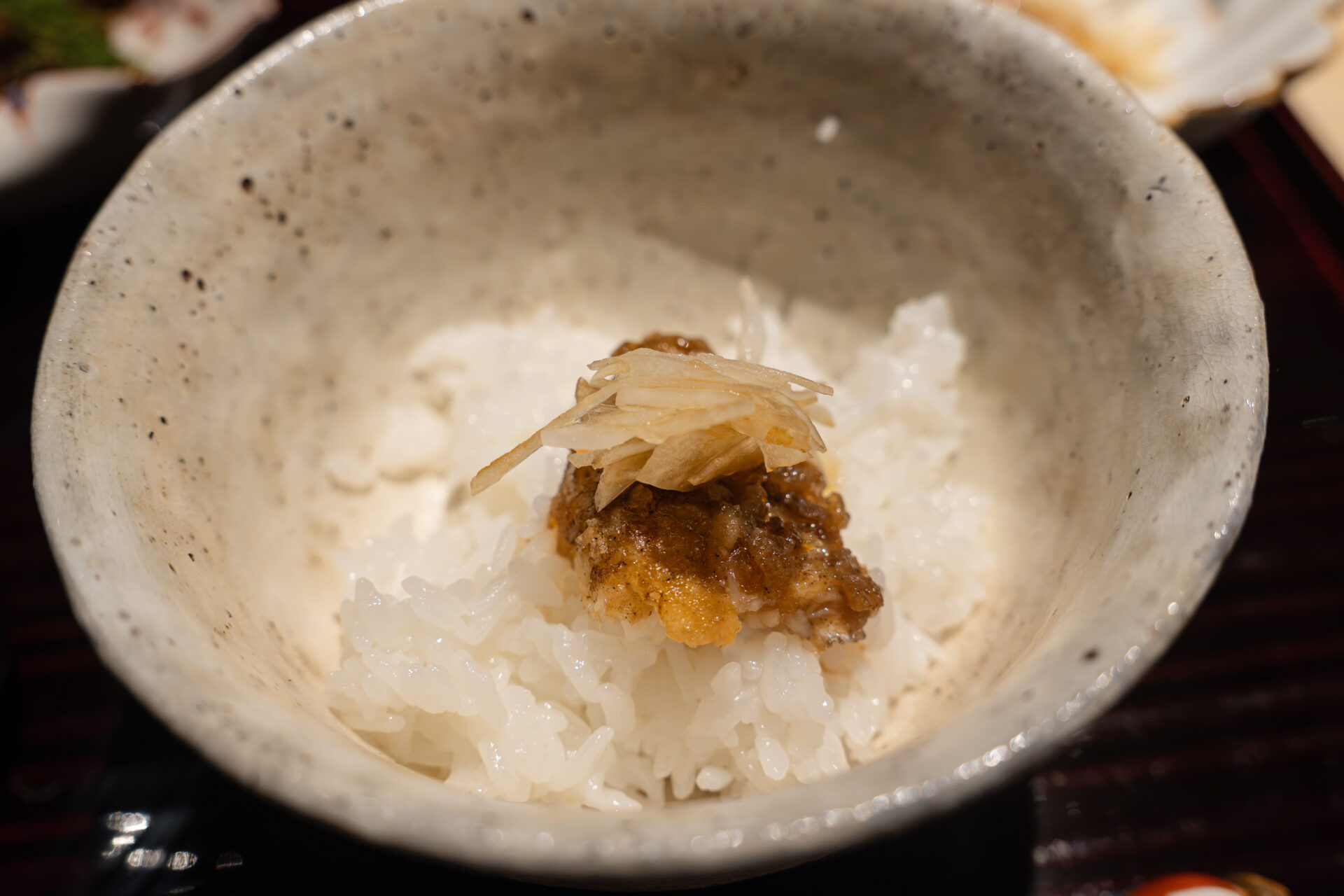
Dessert & Finale
For dessert, strawberries from Genki Farm—run by a junior of Chef Arai—were featured.
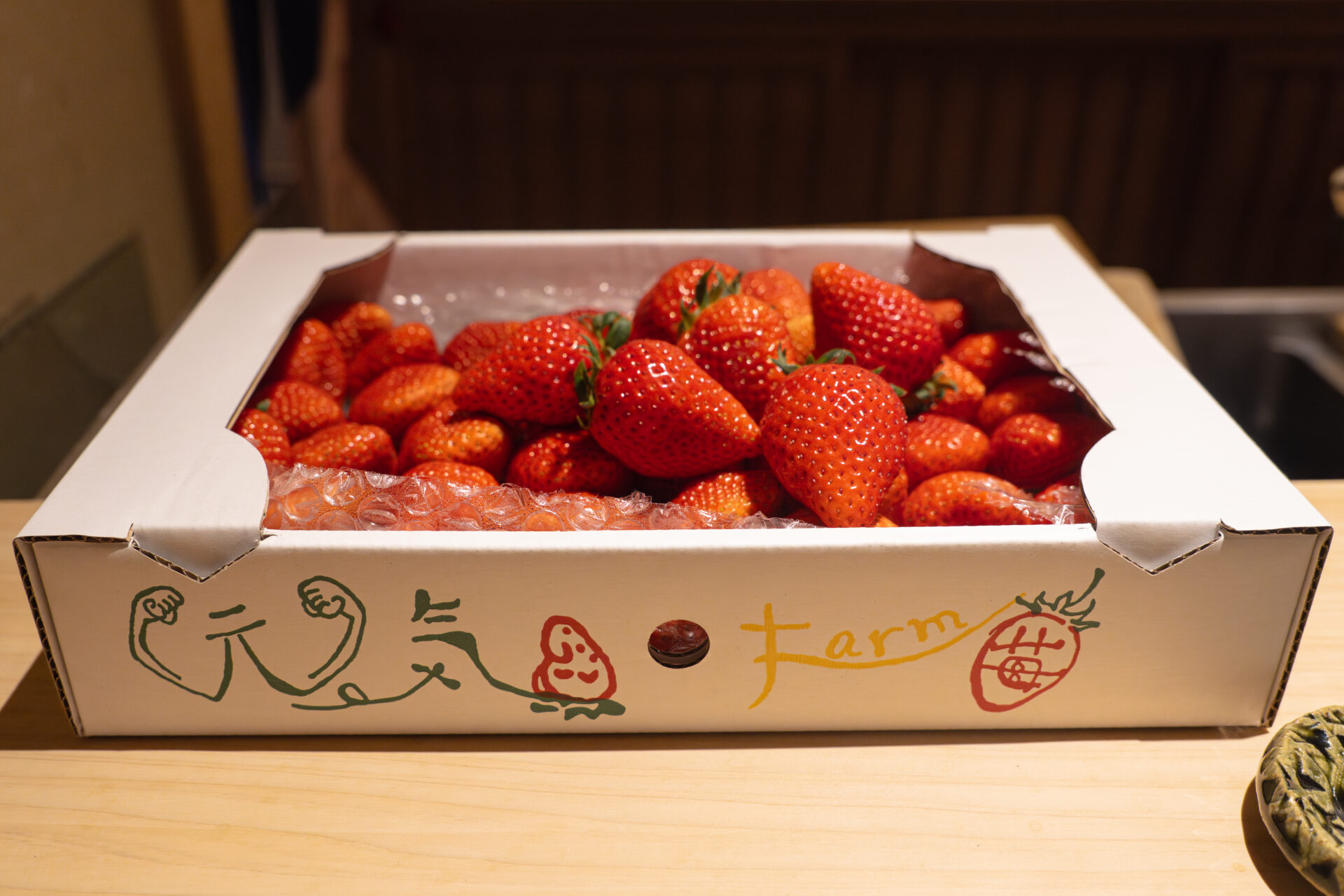
Strawberry Daifuku
The ichigo daifuku (strawberry mochi) was crafted right before our eyes, adding a touch of theatrical elegance. A plump, juicy strawberry was gently wrapped in lightly sweetened red bean paste and tender gyuhi mochi, creating a delicate and refined sweet to end the meal.
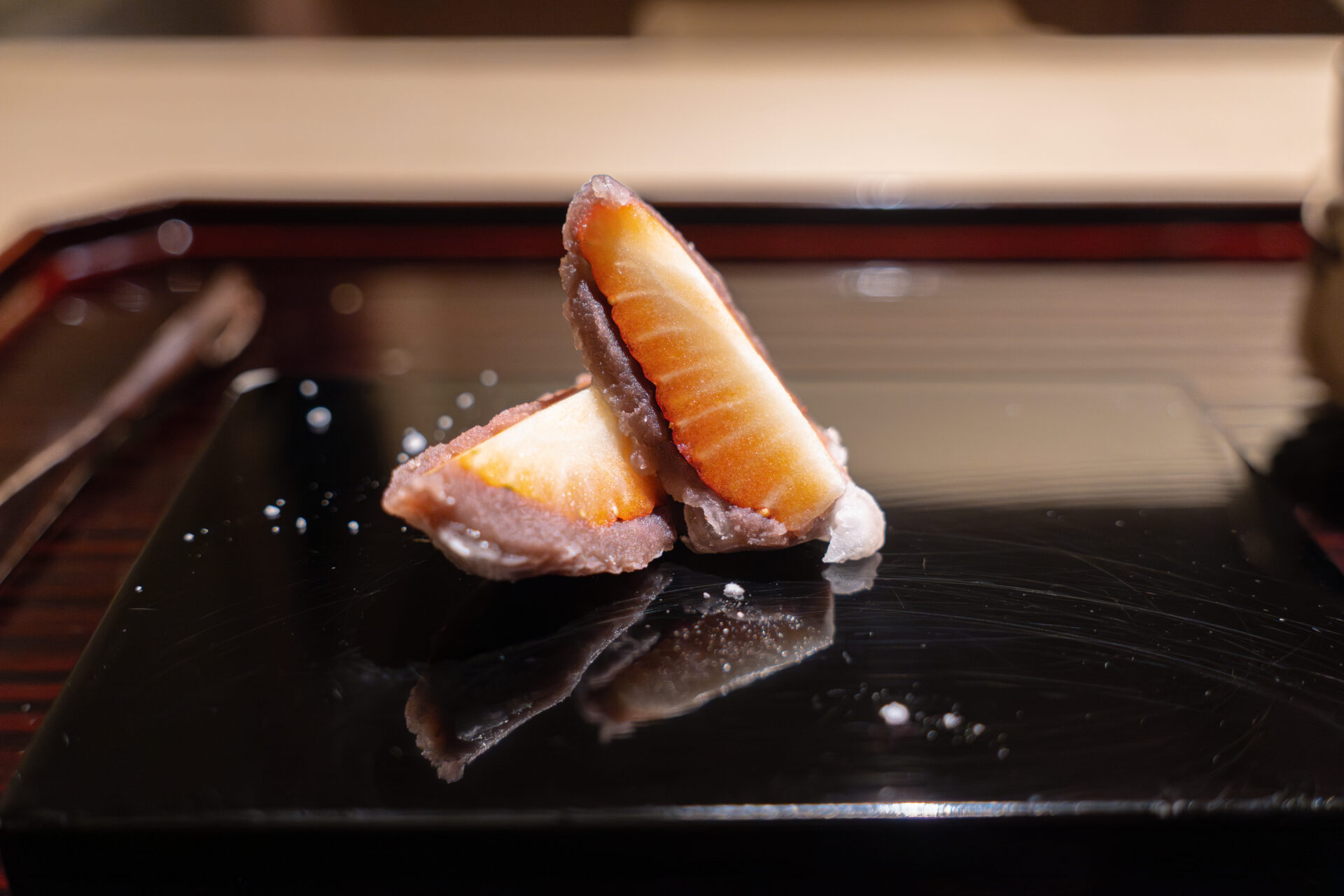
Warabi Mochi
The final dessert was warabi mochi, with a melt-in-your-mouth, jelly-like texture.
Deceptively simple, this sweet demonstrated the precision of flavor balance. A perfectly satisfying conclusion that lingered with quiet elegance to the very last bite.
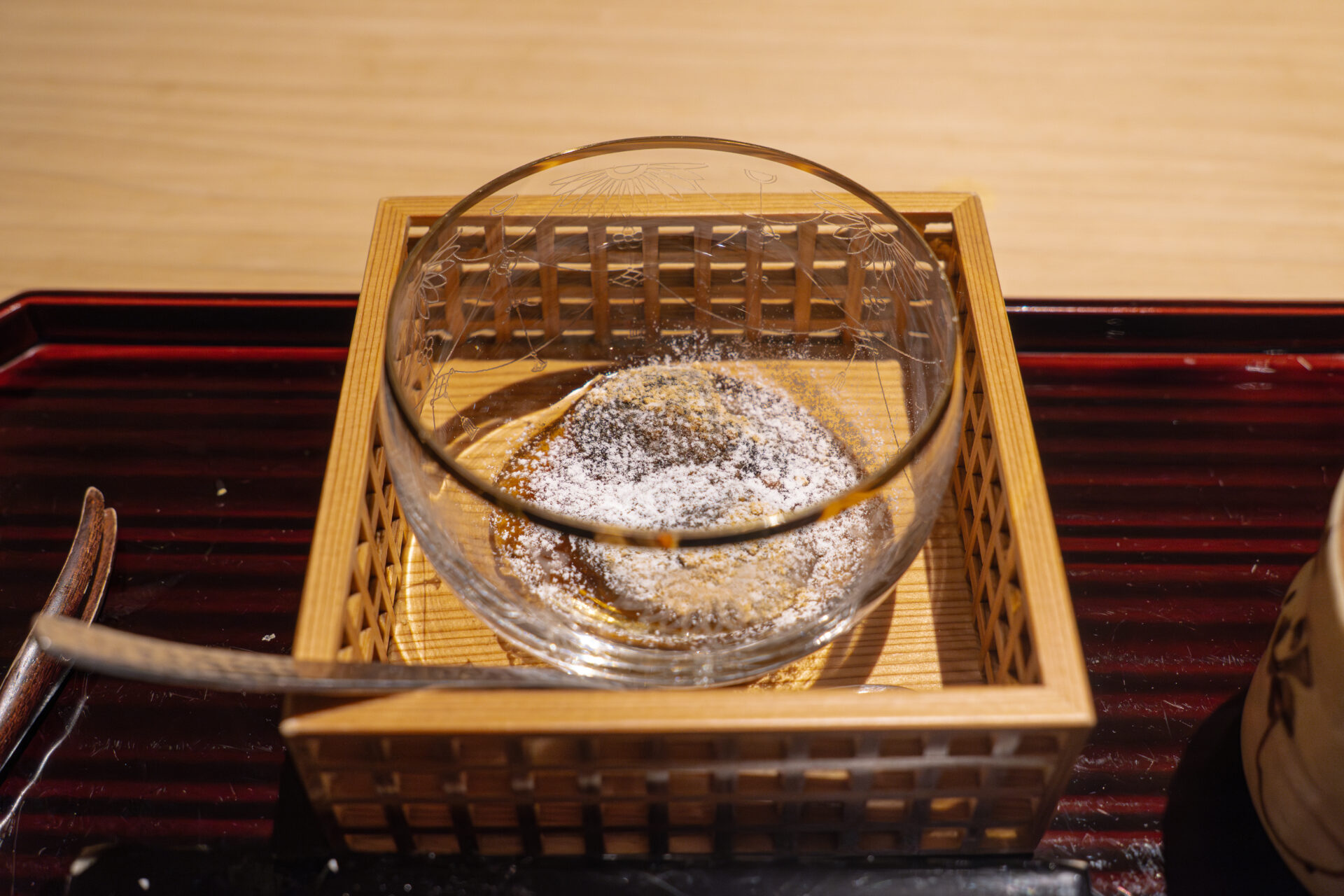
Reflection
Dining at Aji Arai was more than a meal—it was a narrative told through food, an experience that unfolded like a beautifully written story.
Every dish reflected Chef Arai’s meticulous technique and deep respect for ingredients. From the straw-seared bonito tataki made with rice straw from a partnered farm, to the freshly assembled ichigo daifuku, to the comforting miso soup overflowing with ingredients, each element was infused with the chef’s intention and care.
One unique aspect of the experience was being shown the raw ingredients before they were cooked, allowing diners to fully appreciate the transformation process. The moment of seeing the 10-kilogram bonito, tasting it as tataki, and then savoring the adjacent cut as nigiri sushi encapsulated the true essence of Japanese cuisine—elevating the ingredient to its fullest potential.
The clay pot rice and generous miso soup at the end warmed both body and soul. Even the warabi mochi dessert was served with the same level of attentiveness, making you want to savor every last bite.
With attention paid to every detail and heartfelt hospitality throughout, the meal offered a deeply sensory encounter with the bounty of Nakatsu, Oita—a truly special moment in time.
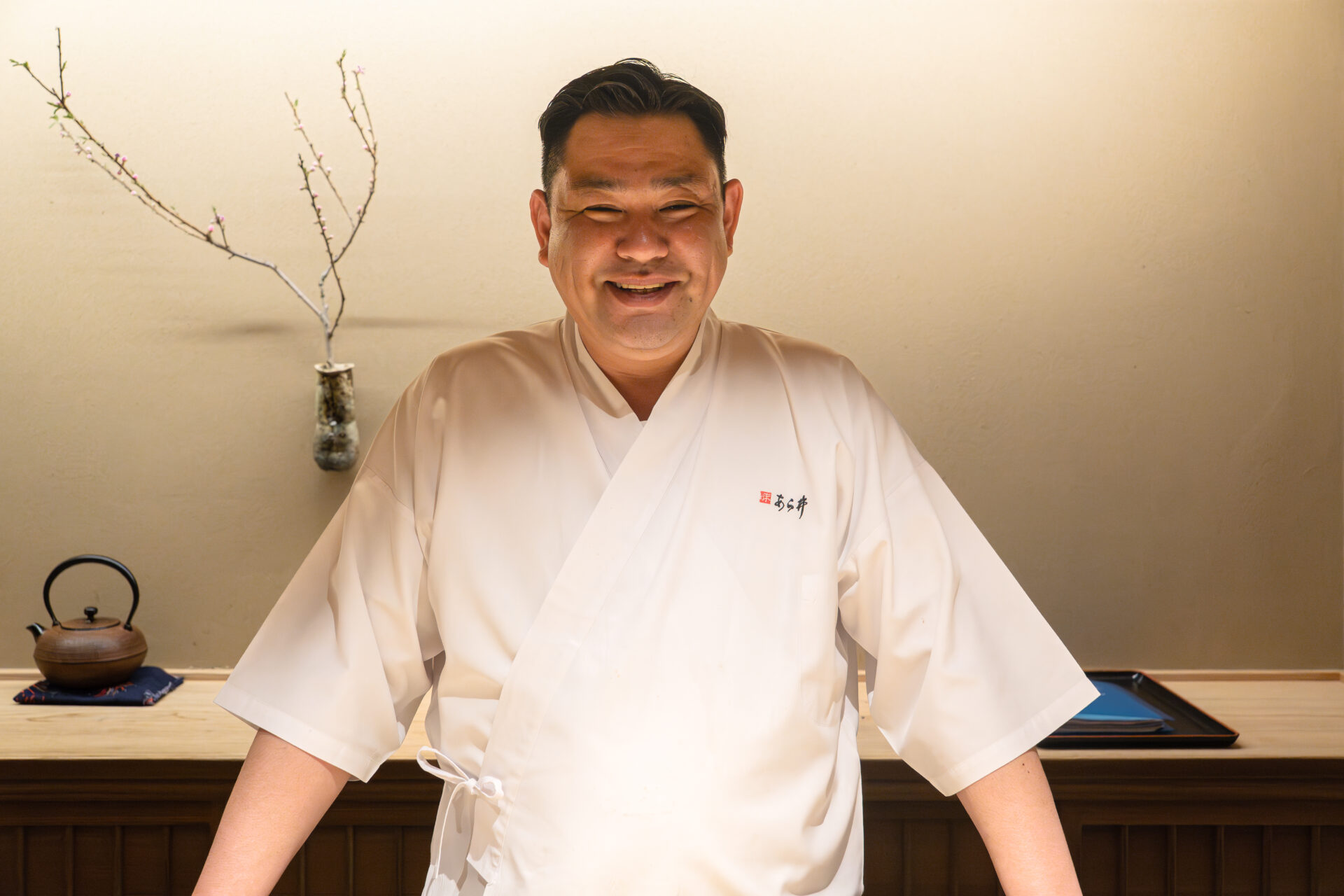
Reservations & Access
How to Reserve:
Reservations can be made through the following methods:
-
Phone Reservation: Call the restaurant directly.
-
Online Reservation: Available via the OMAKASE booking platform.
Access:
-
Address: 2001 Kamihakata-machi, Nakatsu City, Oita Prefecture
-
Nearest Station: Approximately 10 minutes on foot from Nakatsu Station on the JR Nippo Main Line
-
Parking: On-site parking available
Hours:
As of July 2021, Aji Arai operates in two fixed seatings:
-
Counter Seating: 16:00 / 19:00
-
Tatami Seating: 19:00 only
-
Closed on Sundays
Please Note:
Cancellation fees may apply depending on the timing of your changes. Please confirm the cancellation policy when booking.
We recommend checking the most up-to-date information in advance before your visit.
- TAGS

